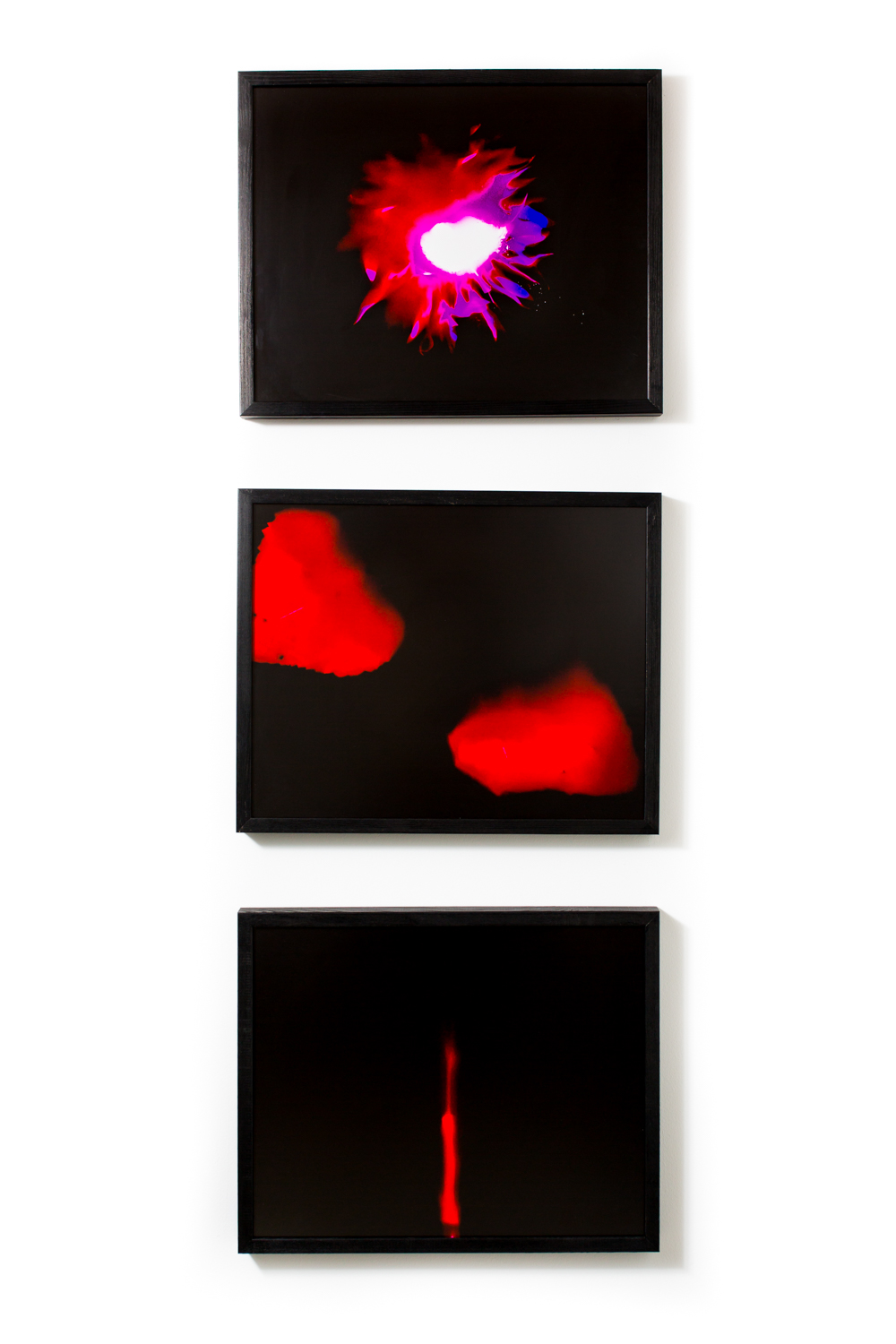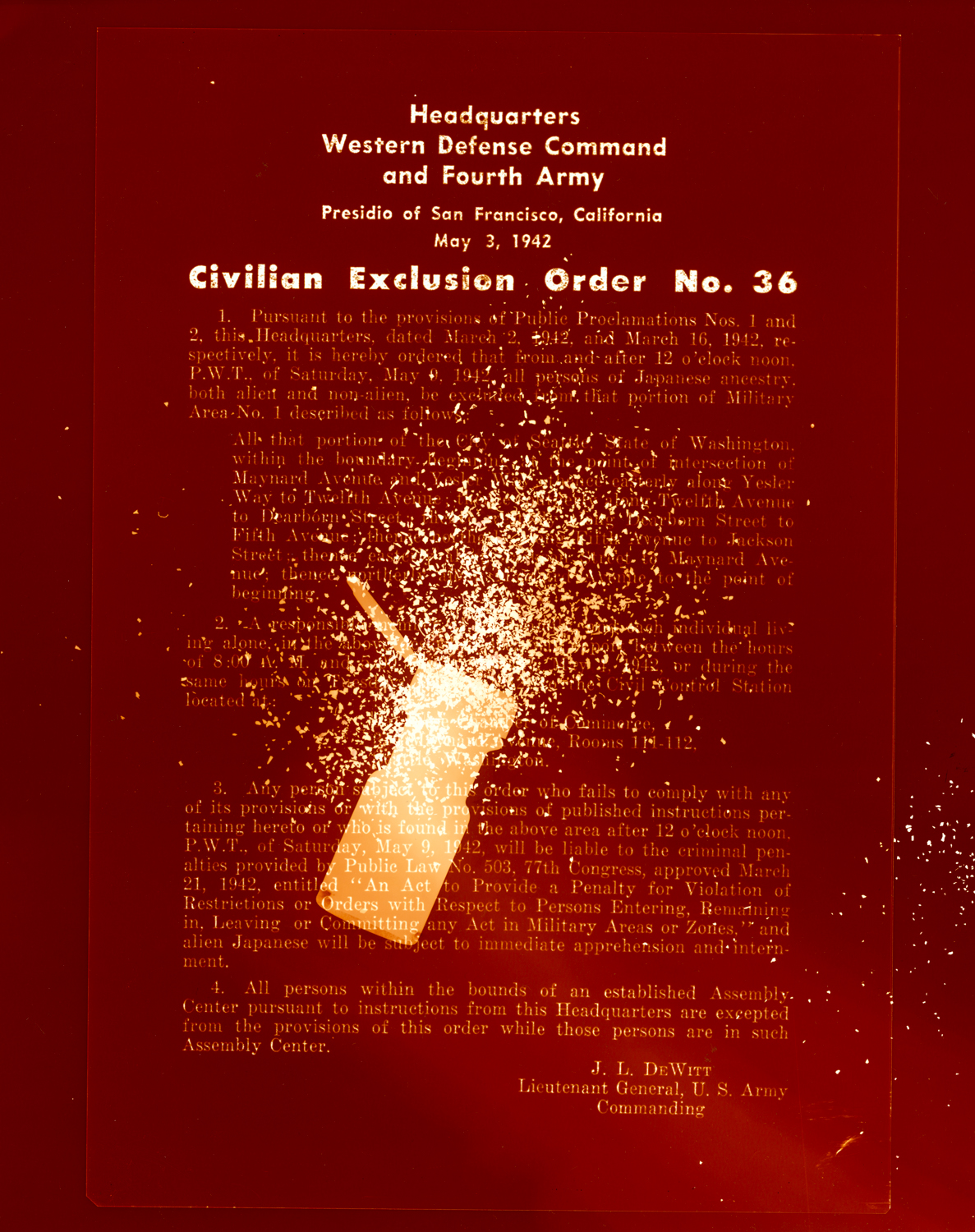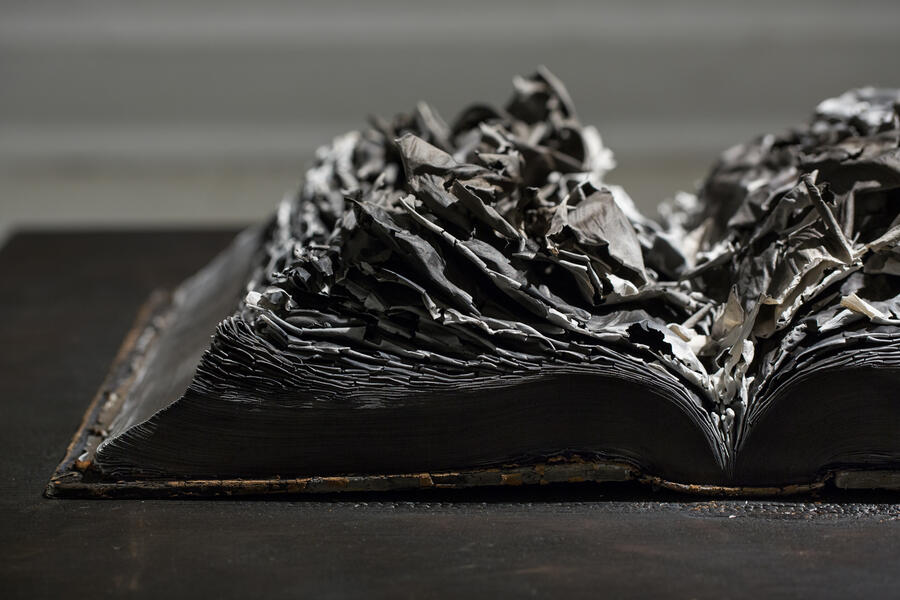About Kei
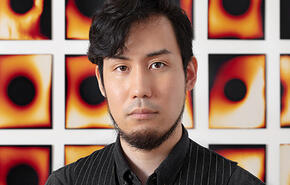
Kei Ito (b. 1991) is an interdisciplinary installation artist working primarily with photographic media and sculpture. Ito received his BFA from Rochester Institute of Technology followed by his MFA from Maryland Institute College of Art.
Ito’s photographs are fundamentally rooted in the trauma and legacy passed down from his late grandfather, a survivor of the atomic bombing of Hiroshima, and the loss of many other family members from the explosion and subsequent radiation poisoning… more
Sungazing
On August 6th 1945, at 8:15 AM, my grandfather witnessed a great tragedy that destroyed nearly everything in Hiroshima. He survived the bombing, yet he lost many of his family members from the explosion and radiation poisoning. As an activist and author, my grandfather fought against the use of nuclear weaponry throughout his life, until he too passed away from cancer when I was ten years old. I remember him saying that day in Hiroshima was like hundreds of suns lighting up the sky.
In order to express the connection between the sun and my family history, I have created 108 letter size prints and a 200 foot long scroll, made by exposing Type-C photographic paper to sunlight. The pattern on the prints/scroll corresponds to my breath. In a darkened room, I pulled the paper in front of a small aperture to expose it to the sun while inhaling, and paused when exhaling. I repeated this action until I breathed 108 times. 108 is a number with ritual significance in Japanese Buddhism; to mark the Japanese New Year, bells toll 108 times, ridding us of our evil passions and desires, and purifying our souls.
If the black parts of the print remind you of a shadow, it is the shadow of my breath, which is itself a registration of my life, a life I share with and owe to my grandfather. The mark of the atomic blast upon his life and upon his breath was passed on to me, and you can see it as the shadow of this print.
____
Sungazing Prints
2015, 2018
Unique c-print photograms (sunlight, artist's breath), Dibond mounted
Installation size: 108 x 106 in. (Print: 108 of 8 x 10 in.)
Sungazing Scroll
2015 - ongoing
Unique c-print photogram (sunlight, artist's breath)
12 in. x 150 ft. to 220 ft. depending on the edition
Exhibition History:
2024: The Georgia Museum of Art, GA
2020: apexart, NY
2019: Norton Museum of Art, FL
2019: SECCA (Southeastern Center for Contemporary Art), NC
2018: Antioch College, OH
2017: Museum of Contemporary Photography, IL
2016: Towson University, MD
2016: Manifest Gallery, OH
2015: California Institute of Integral Studies, CA
-
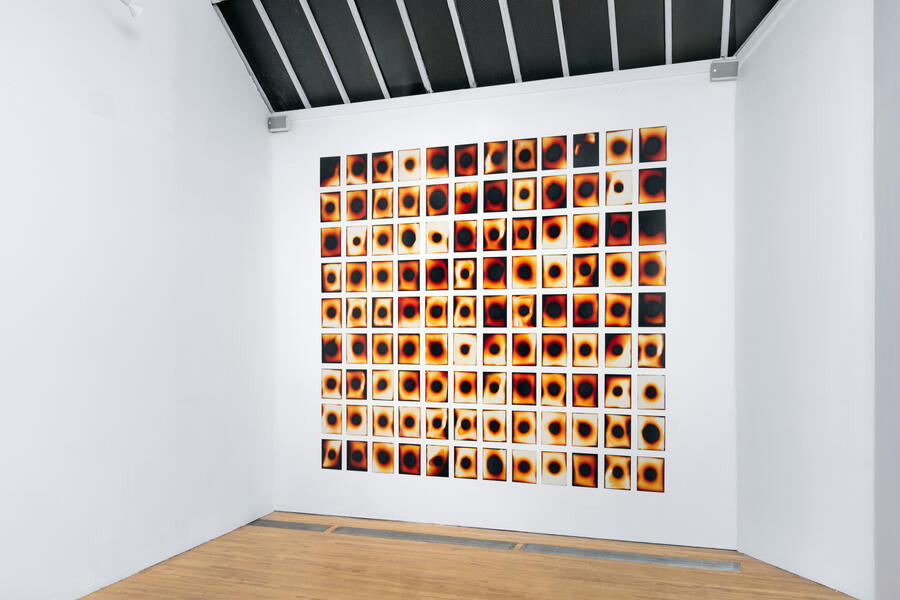 Sungazing Print: Apexart 2020Installation view at Apexart, NYC, NY, (2020)
Sungazing Print: Apexart 2020Installation view at Apexart, NYC, NY, (2020) -
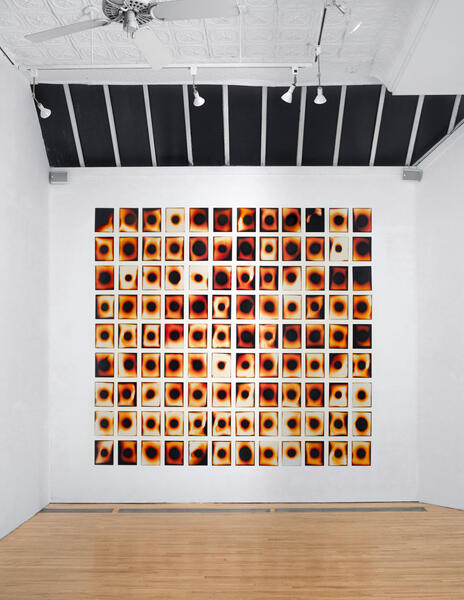 Sungazing Print: Apexart 2020
Sungazing Print: Apexart 2020Installation view at Apexart, NYC, NY, (2020)
-
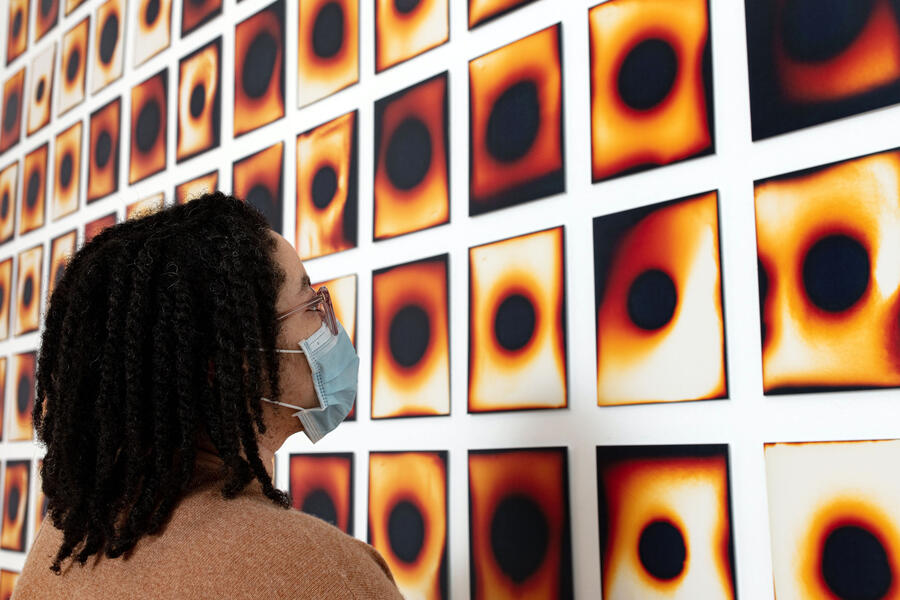 Sungazing Print: Apexart 2020Installation view at Apexart, NYC, NY, (2020)
Sungazing Print: Apexart 2020Installation view at Apexart, NYC, NY, (2020) -
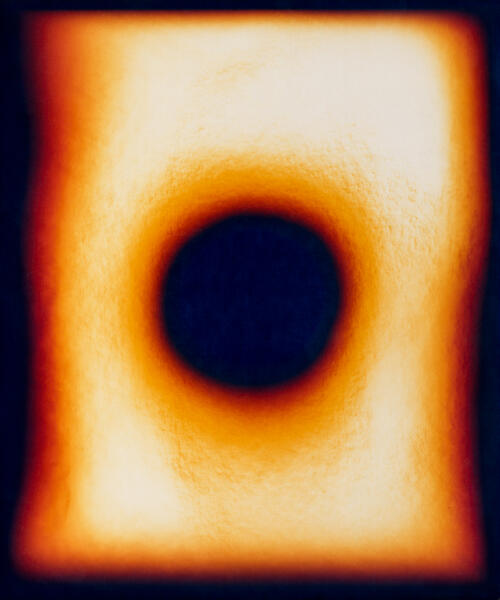 Sungazing 1/108
Sungazing 1/108 -
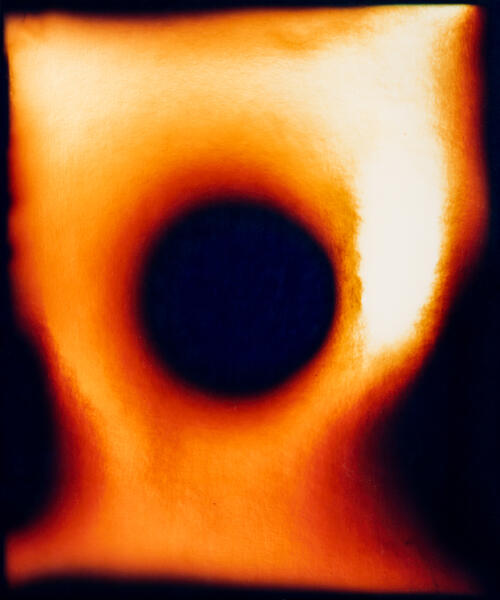 Sungazing 24/108
Sungazing 24/108 -
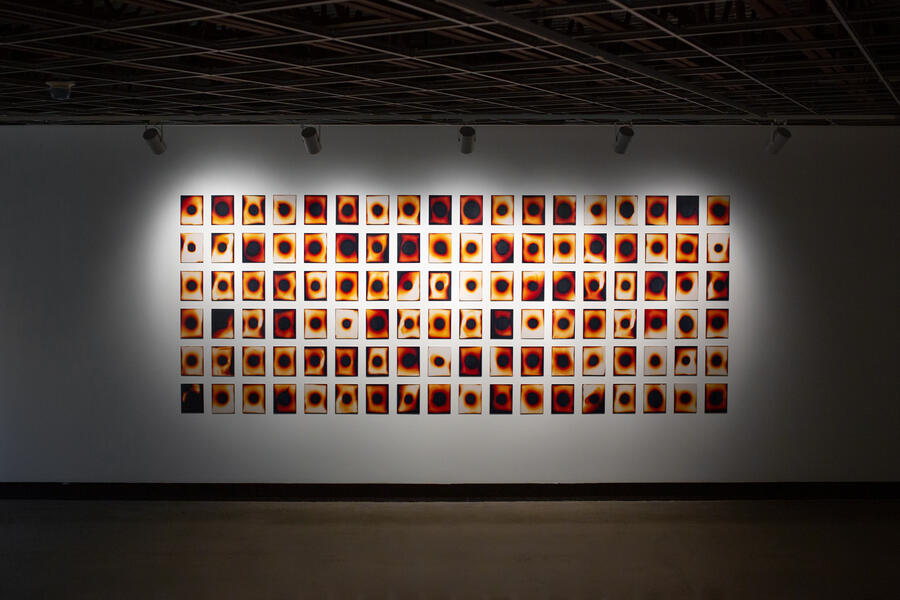 Sungazing Print: SECCA 2019Installation View at Southeastern Center for Contemporary Art(SECCA), NC (2019)
Sungazing Print: SECCA 2019Installation View at Southeastern Center for Contemporary Art(SECCA), NC (2019) -
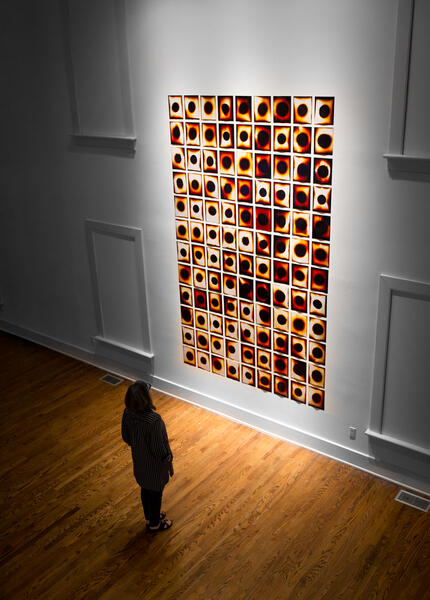 Sungazing Print: Herndon Gallery/ Antioch College 2018Installation view at Herndon Gallery/ Antioch College, Part of the FotoFocus Biennial, OH (2018)
Sungazing Print: Herndon Gallery/ Antioch College 2018Installation view at Herndon Gallery/ Antioch College, Part of the FotoFocus Biennial, OH (2018) -
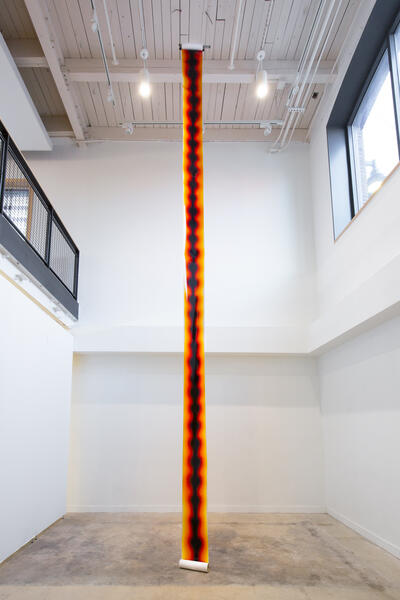 Sungazing Scroll: MICA 2017Installation view at MICA, MD (2017)
Sungazing Scroll: MICA 2017Installation view at MICA, MD (2017) -
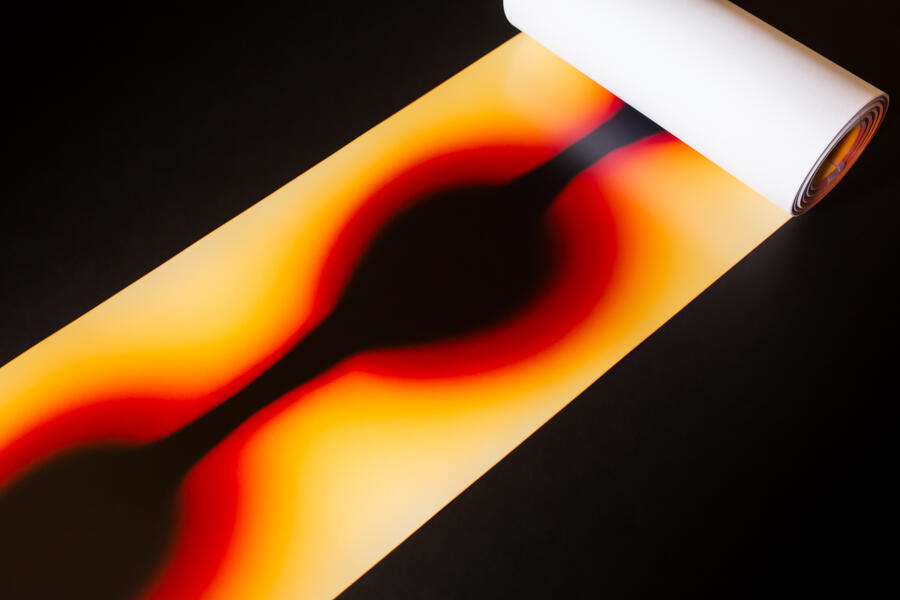 Sungazing Scroll: Norton Museum of Art 2019Installation view at the Norton Museum of Art, West Palm Beach, FL (2019)
Sungazing Scroll: Norton Museum of Art 2019Installation view at the Norton Museum of Art, West Palm Beach, FL (2019) -
 Sungazing Scroll (Section)A scanned section of Sungazing Scroll 2017
Sungazing Scroll (Section)A scanned section of Sungazing Scroll 2017
Afterimage Requiem
Afterimage Requiem is a large-scale visual and sound installation containing 108 human-scale photograms and a 4-channel sound work made by my collaborator, Andrew Keiper.
The installation probes the atomic bombing of Hiroshima and the intertwined family histories between Keiper and I. On August 6th 1945, at 8:15 AM, my grandfather witnessed a great tragedy that destroyed nearly everything in Hiroshima. Meanwhile, Keiper’s grandfather was an engineer who participated in the development of the Atomic bomb during the Manhattan Project. Two generations later, Keiper and I are great friends and collaborators which may have been thought to be impossible for the people a few generations ago.
The 108 photograms show shadow negative exposures of my body on the ground, with the viewer looking down upon it. These c-prints were exposed to sunlight due to my grandfather’s description, “that day in Hiroshima was like hundreds of suns lighting up the sky,” haunting me through my artistic practice. The radiation that my grandfather was exposed to pierced through his skin and inscribed itself onto his genes and onto my own; our bodies are now being “captured” through time and history, film and DNA. The number 108 holds significance in Japanese Buddhism, a number that embodies redemption from the evil passions we possess. As Keiper’s sound plays above in the air, my body lies on the ground, our grandfather’s positions are echoed in the space but our stances have changed. Each print is a prayer for the future.
This installation grapples with this history while asserting its pertinence to a contemporary audience living in an increasingly unstable political landscape. My photograms and Keiper’s 4-channel sound work portrays the bomb’s production created using the recordings made at atomic heritage sites in New Mexico and Chicago; the installation seeks mutual understanding while contemplating the roots, sorrow, and scope of the bombing. In an era of overt nuclear crisis unlike any seen in decades, Afterimage Requiem asks the audience to reflect on the ramifications of our current course, and to learn from the past.
____
Afterimage Requiem
2018
Unique c-print photograms (artist's body, sunlight, artist's breath), pebble, spot light, 4-ch audio composed by Andrew Paul Keiper
Installation: Various (108 of 30 x various heights in. prints)
-
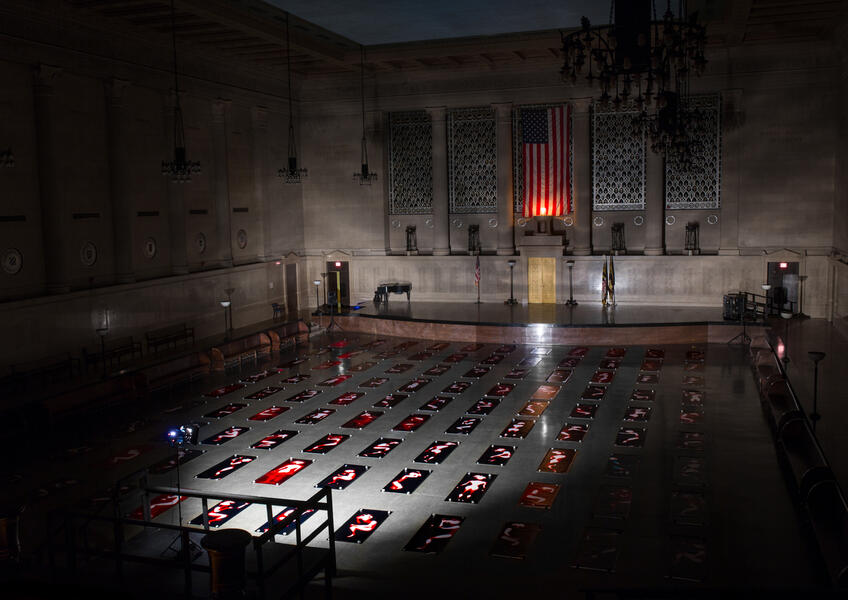 Afterimage Requiem: Baltimore War Memorial 2018Installation view at Baltimore War Memorial, MD (2018)
Afterimage Requiem: Baltimore War Memorial 2018Installation view at Baltimore War Memorial, MD (2018) -
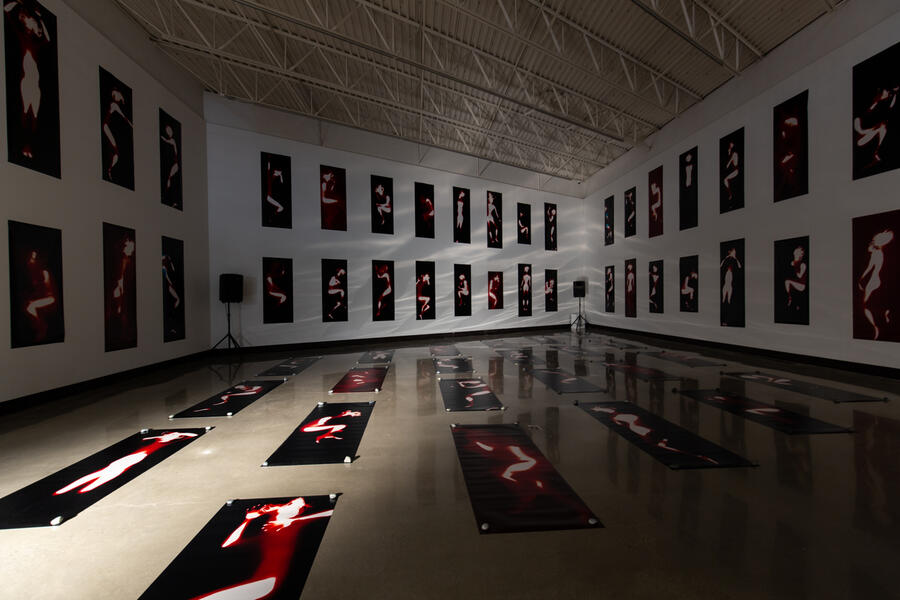 Afterimage Requiem: SECCA 2019Installation view at Southeastern Center for Contemporary Art: SECCA, NC (2019)
Afterimage Requiem: SECCA 2019Installation view at Southeastern Center for Contemporary Art: SECCA, NC (2019) -
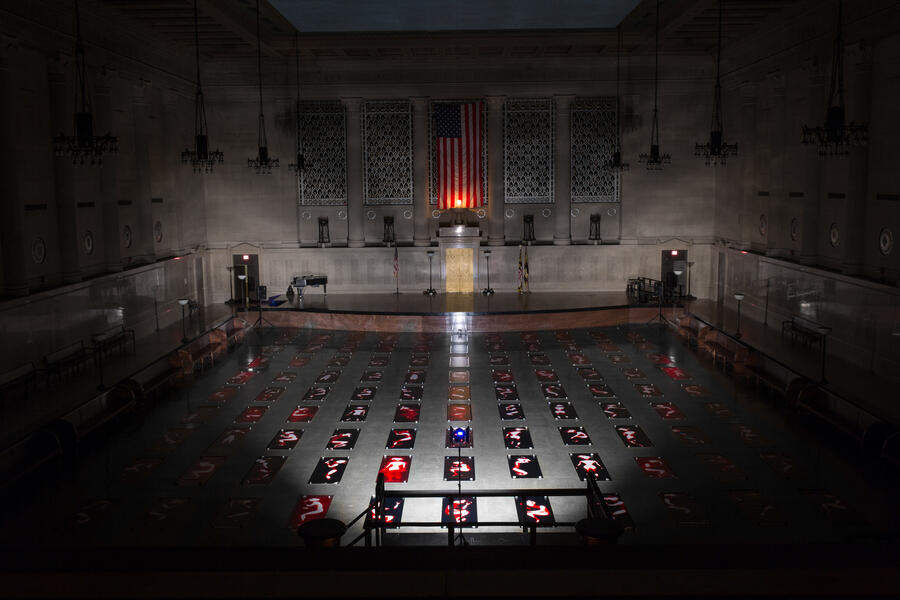 Afterimage Requiem: Baltimore War Memorial 2018Installation view at Baltimore War Memorial, MD (2018)
Afterimage Requiem: Baltimore War Memorial 2018Installation view at Baltimore War Memorial, MD (2018) -
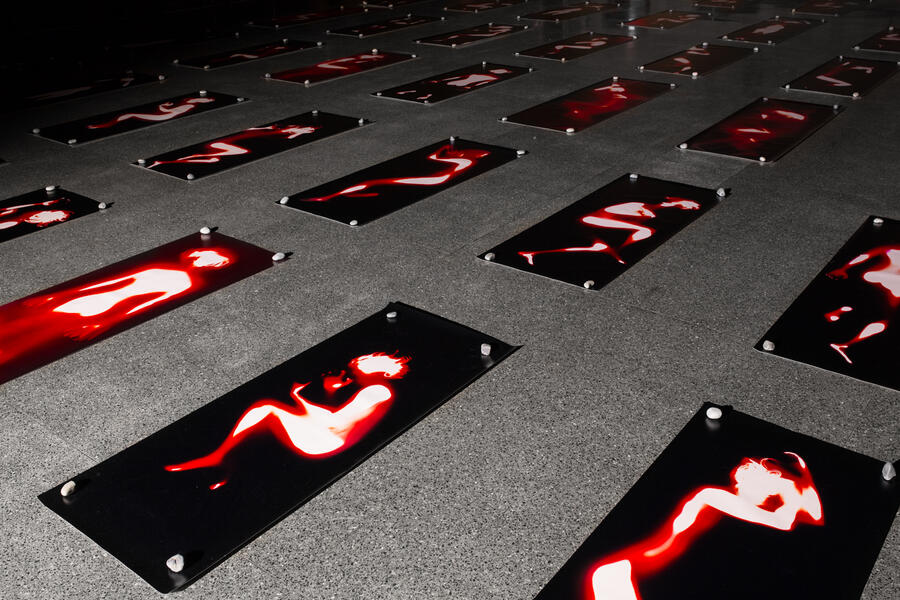 Afterimage Requiem: Baltimore War Memorial 2018Installation view at Baltimore War Memorial, MD (2018)
Afterimage Requiem: Baltimore War Memorial 2018Installation view at Baltimore War Memorial, MD (2018) -
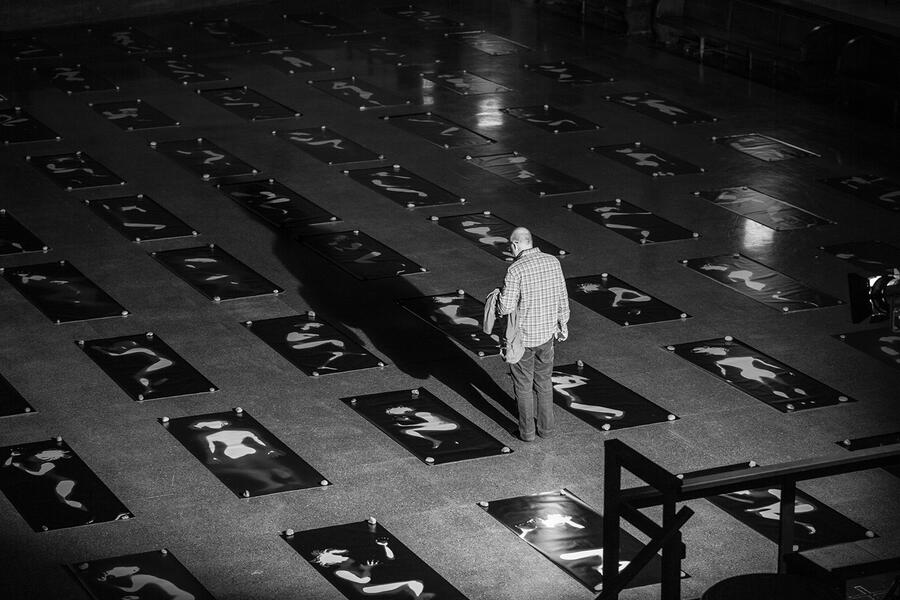 Afterimage Requiem: Baltimore War Memorial 2018Installation view at Baltimore War Memorial, MD (2018)
Afterimage Requiem: Baltimore War Memorial 2018Installation view at Baltimore War Memorial, MD (2018) -
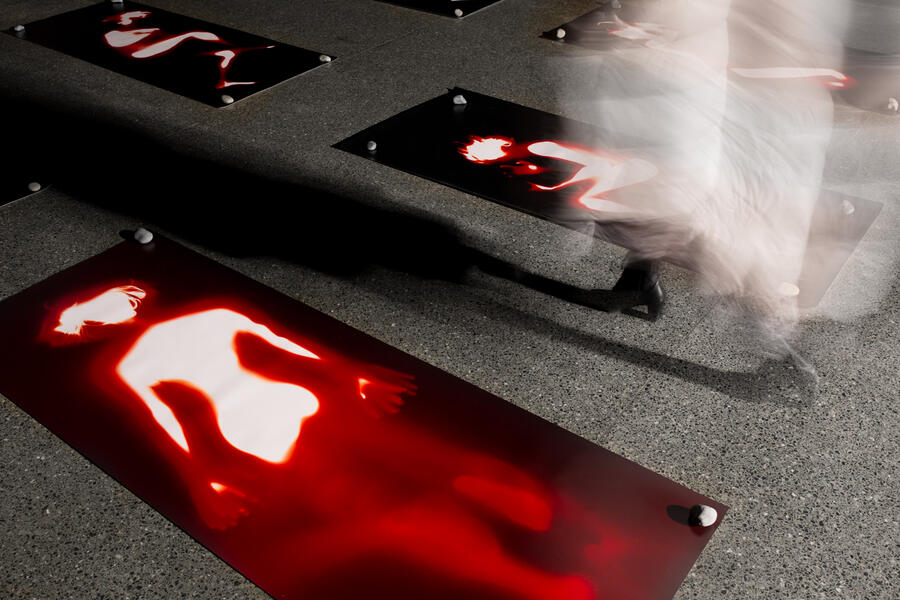 Afterimage Requiem: Baltimore War Memorial 2018Installation view at Baltimore War Memorial, MD (2018)
Afterimage Requiem: Baltimore War Memorial 2018Installation view at Baltimore War Memorial, MD (2018) -
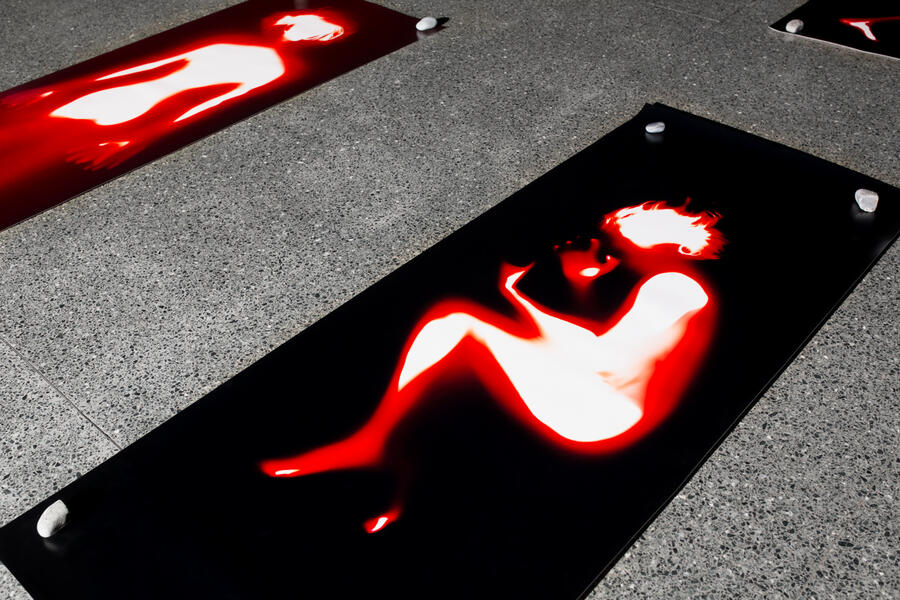 Afterimage Requiem: Baltimore War Memorial 2018
Afterimage Requiem: Baltimore War Memorial 2018 -
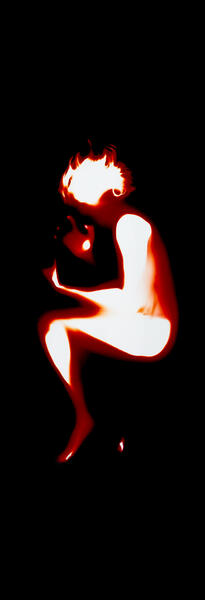 Afterimage Requiem 1/108
Afterimage Requiem 1/108 -
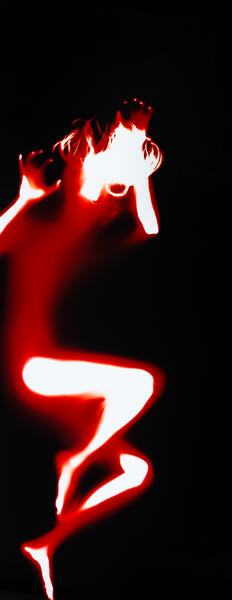 Afterimage Requiem 35/108
Afterimage Requiem 35/108 -
 Afterimage Requiem (108 Prints)
Afterimage Requiem (108 Prints)
Infertile American Dream
The increase of nuclear armaments worldwide, and the ramping up of nuclear tensions between the US and North Korea harken back to the terror of my grandfather’s experience during the bombing of Hiroshima in 1945. By his account, it seemed as though the sky was lit by hundreds of suns. On that day, the very fabric of life that he knew, his friends, family, and even the landscapes of the city were completely annihilated. Any trace of home seemed to never have existed, as if his home was never even built.
As a 3rd generation A-bomb victim who is now a resident of America, I find the chaos in the current political establishment unbearable. Political divides have deepened, and nuclear war seems closer on the horizon than it has ever been in my lifetime. Blind fear directed towards to a group of people through prejudice and misunderstanding caused by media; the realization that the home, in both physical and spiritual sense, can be taken away as quickly as thirty minutes by a single bomb and the chain reaction that follows. After we reach the point of no return, the American Dream will be unsustainable--an empty and barren wasteland filled with nothing but ash left for future generations. Like the unassembled home in Infertile American Dream, our children will not be able to have a chance to conceive their ideal vision of hope for the future.
A Nation Follows Where It Leads was made in 2018 as a follow up to the project. A C-print photogram made with an American Flag on 06/14/2018 which is both US Flag Day and President Trump’s birthday.
Infertile American Dream
2016-2021
Chromogenic Print(C-print), Sunlight, Model of House, Wooden Frame
Triptych of 27”x38”
Exhibition History:
2017: School 33, MD
2018: 14x48 NYC Art Billboard Project, NY
2018: IA&A at Hillyer (Hillyer Art Space), DC
2019: Candela Gallery, VA
-
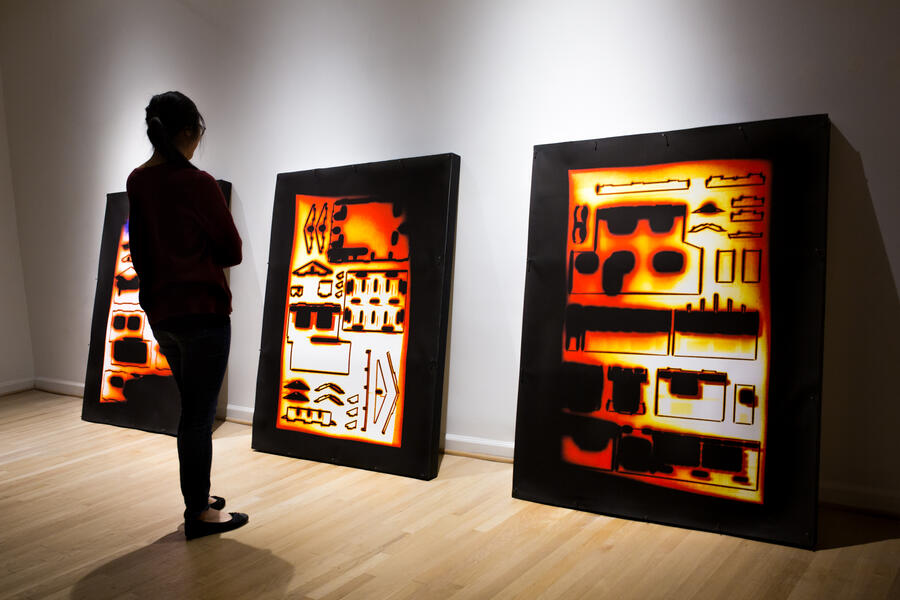 Infertile American Dream: IA&A at Hillyer 2018Installation view at IA&A at Hillyer, Washington, DC (2018)
Infertile American Dream: IA&A at Hillyer 2018Installation view at IA&A at Hillyer, Washington, DC (2018) -
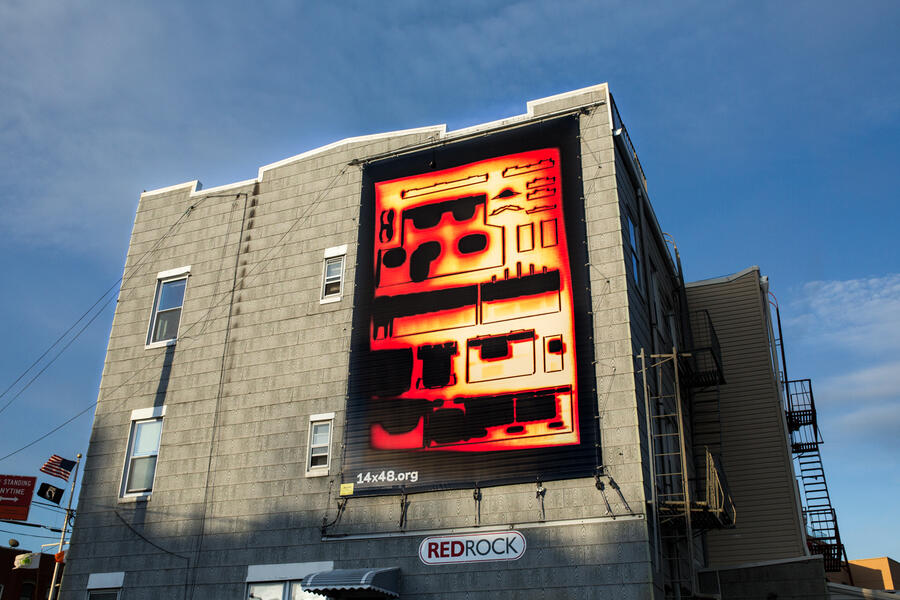 Infertile American Dream: Art BillboardArt Billboard sponsored by 14x48.org, Woodpoint Rd/Conselyea St in Brooklyn, NYC, near Graham Av L station.
Infertile American Dream: Art BillboardArt Billboard sponsored by 14x48.org, Woodpoint Rd/Conselyea St in Brooklyn, NYC, near Graham Av L station. -
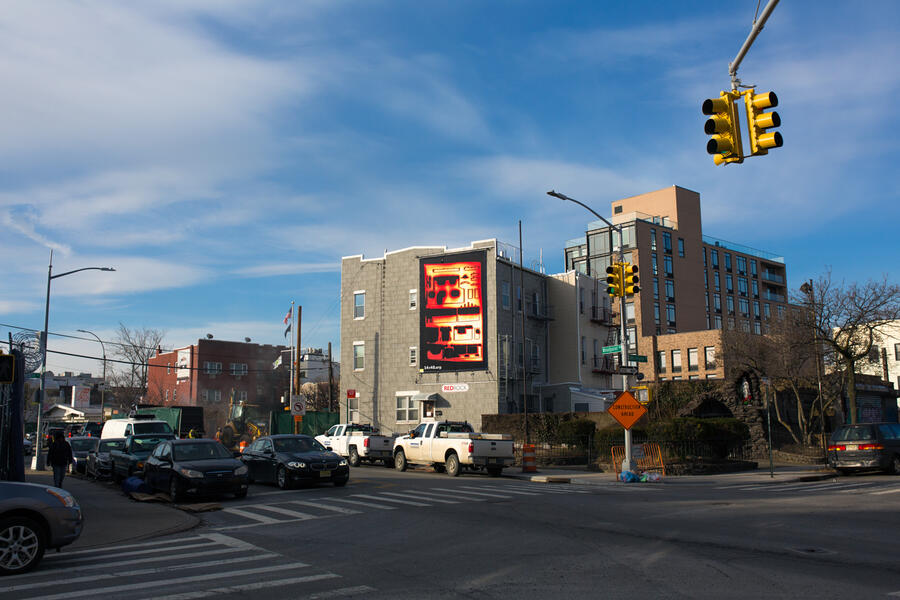 Infertile American Dream: Art BillboardArt Billboard sponsored by 14x48.org, Woodpoint Rd/Conselyea St in Brooklyn, NYC, near Graham Av L station.
Infertile American Dream: Art BillboardArt Billboard sponsored by 14x48.org, Woodpoint Rd/Conselyea St in Brooklyn, NYC, near Graham Av L station. -
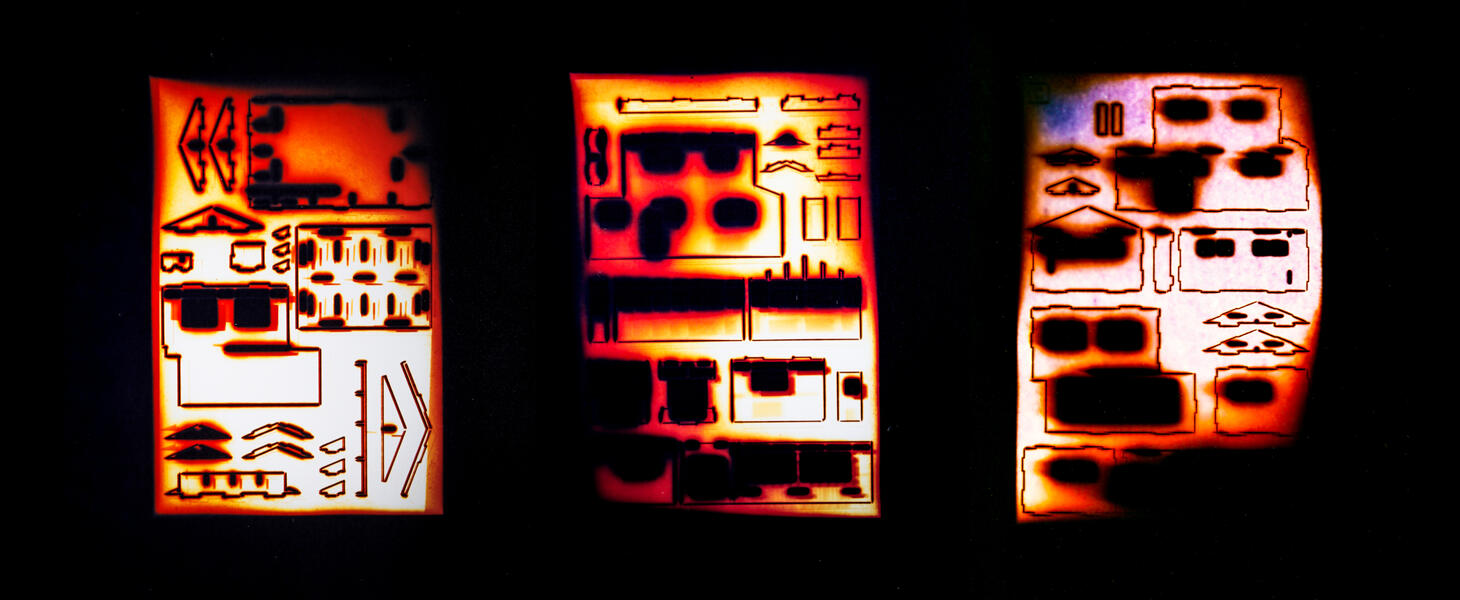 Infertile American Dream
Infertile American Dream -
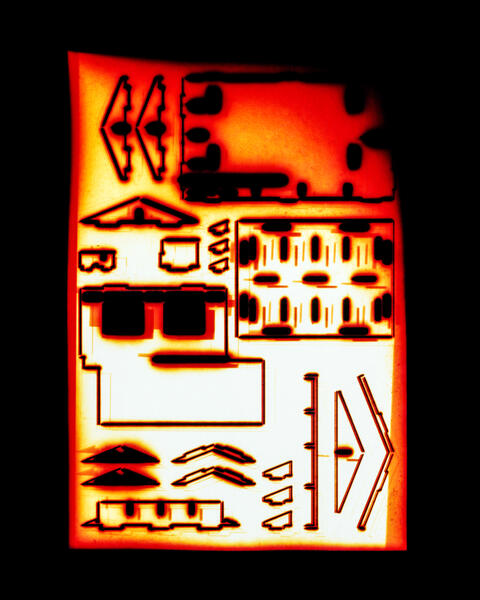 Infertile American Dream: Detail 1/3Infertile American Dream is a triptych of C-prints, which were created by exposing light-sensitive paper to sunlight on the day the 45th US president was elected.
Infertile American Dream: Detail 1/3Infertile American Dream is a triptych of C-prints, which were created by exposing light-sensitive paper to sunlight on the day the 45th US president was elected. -
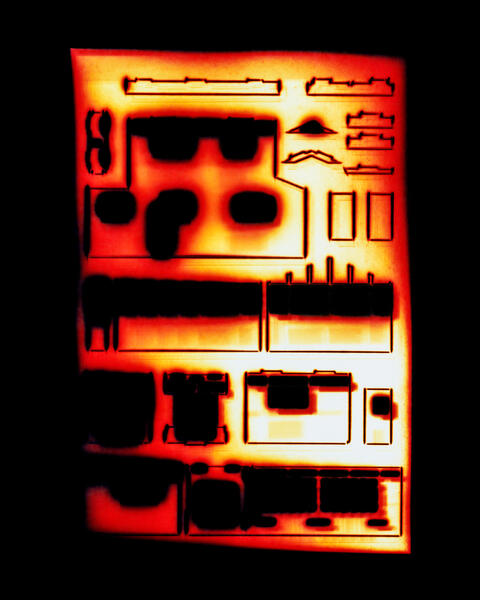 Infertile American Dream: Detail 2/3
Infertile American Dream: Detail 2/3 -
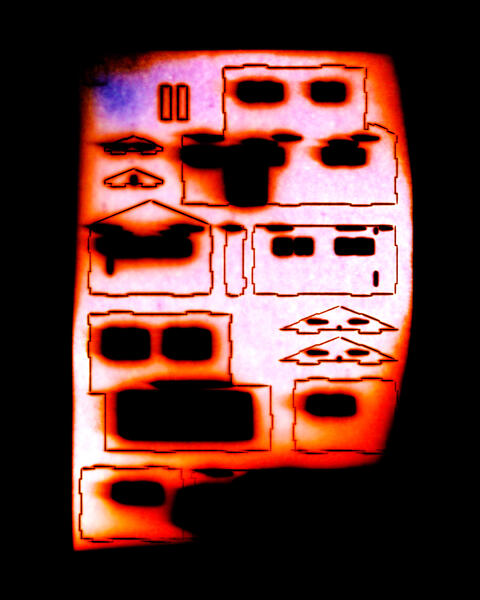 Infertile American Dream: Detail 3/3
Infertile American Dream: Detail 3/3 -
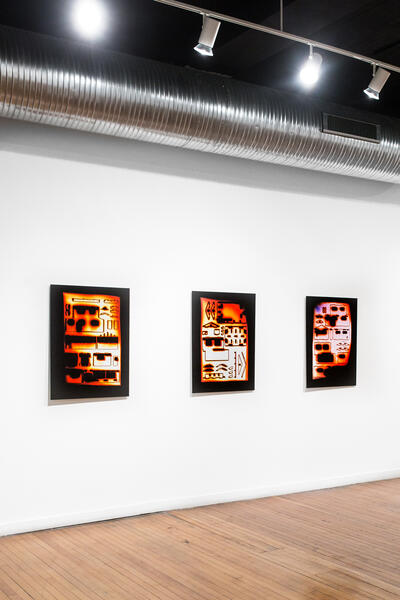 Infertile American Dream: School 33, 2017Installation view at School 33 Art Center, Baltimore, MD (2017)
Infertile American Dream: School 33, 2017Installation view at School 33 Art Center, Baltimore, MD (2017) -
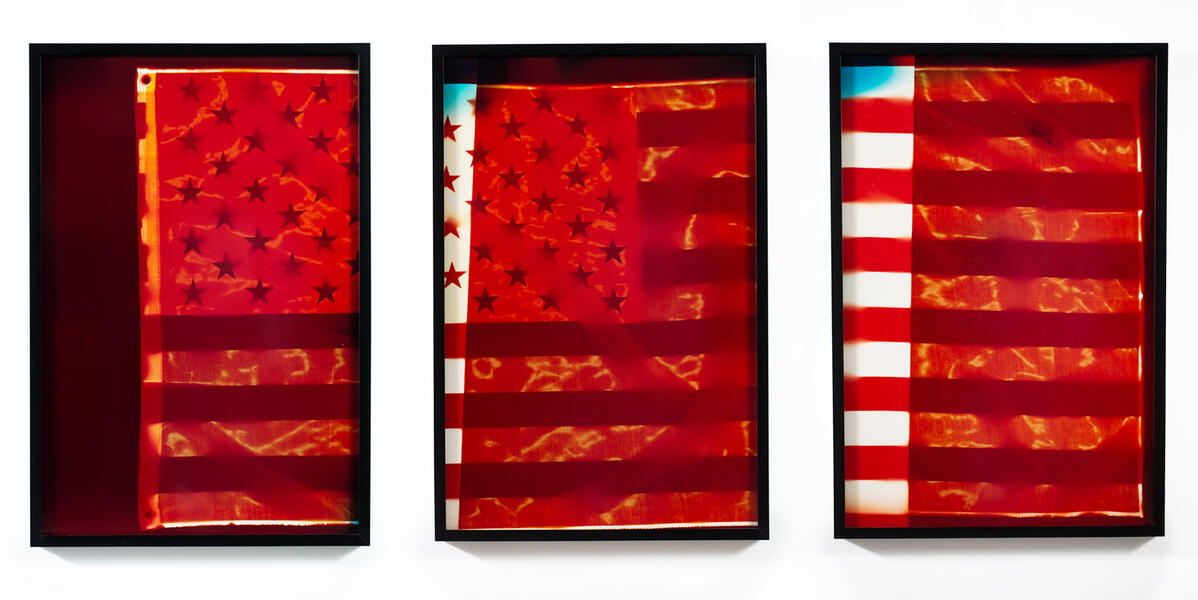 A Nation Follows Where It Leads: Candela Gallery 2019Installation view at Candela Gallery Richmond, VA (2019) A C-print photogram made with an American Flag on 06/14/2018 which is both US Flag Day and President Trump’s birthday.
A Nation Follows Where It Leads: Candela Gallery 2019Installation view at Candela Gallery Richmond, VA (2019) A C-print photogram made with an American Flag on 06/14/2018 which is both US Flag Day and President Trump’s birthday. -
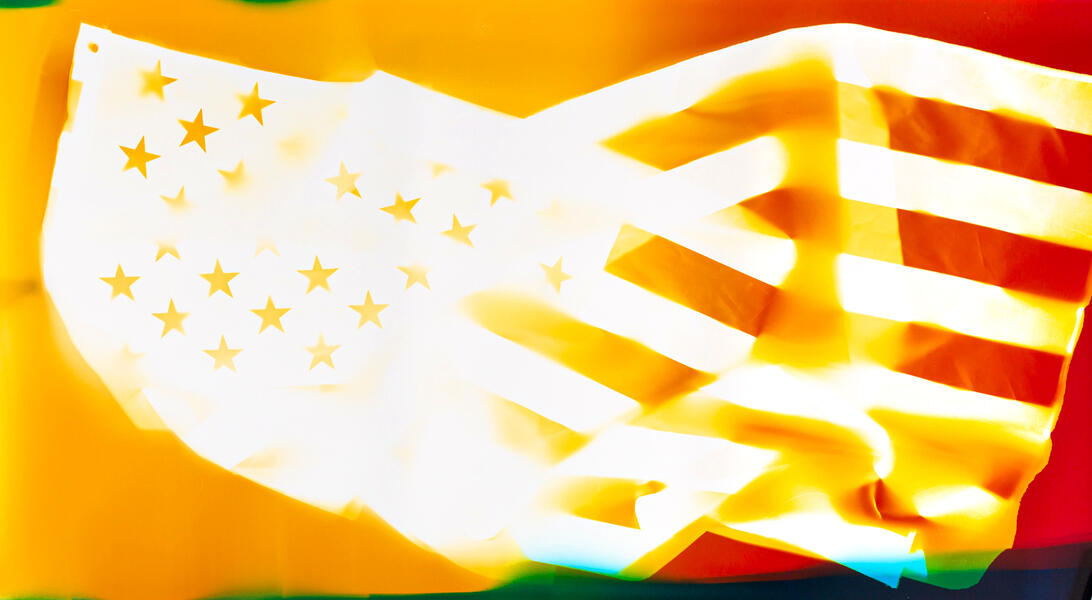 A Nation Follows Where It Leads 2A C-print photogram made with an American Flag on 06/14/2018 which is both US Flag Day and President Trump’s birthday.
A Nation Follows Where It Leads 2A C-print photogram made with an American Flag on 06/14/2018 which is both US Flag Day and President Trump’s birthday.
Luminescent Shadows
Luminesce Shadows is a series of 240 glass slides projected by three carousal projectors, 80 slides each. The images captured on the slides were formed by exposing the plates to extreme heat and causing soot to form. Then, using a brush and paint medium, I fixed the soot on the glass plates. The carousals automatically advance each slide every 30 seconds, creating an endless moving image; an imagined reenactment of the ash of Hiroshima and a future prediction of nuclear winter.
As the tension of potential nuclear war rises, many people whom live in major city such as, NYC, San Francisco, DC, Baltimore and others are always in fear of complete annihilation by atomic light. This series of work seeks to explore the possible visual result we may experience in the future of the skies covered by luminesce ashy shadows.
____Luminescent Shadows
2018
2cmx2cm Glass Slides, Slide Projector, Soot
Various
2018: Virginia Museum of Fine Art as part of the Inlight Richmond
2019: Creative Alliance
-
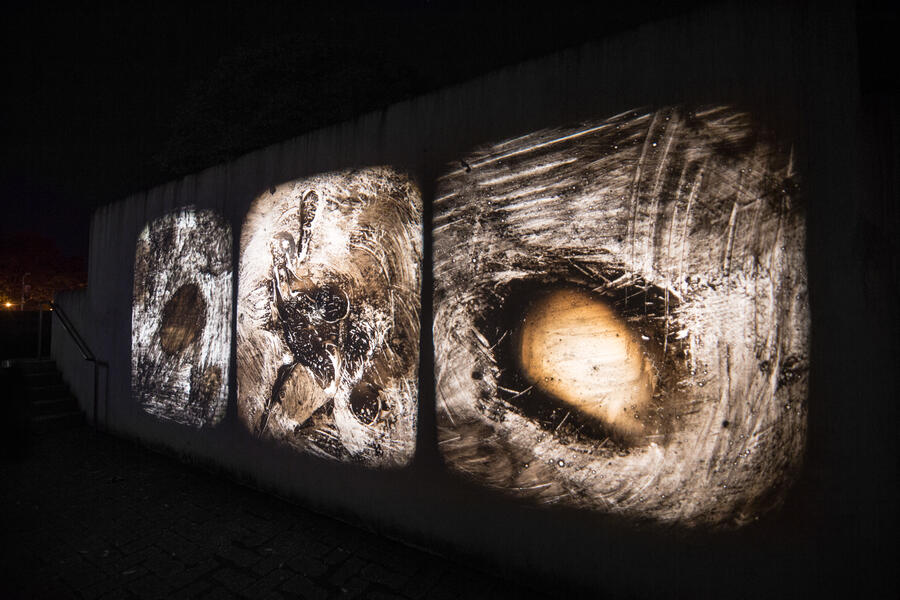 Luminescent Shadows: the Virginia Museum of Fine Art 2018Installation view at the Virginia Museum of Fine Art, Richmond, VA (2018)
Luminescent Shadows: the Virginia Museum of Fine Art 2018Installation view at the Virginia Museum of Fine Art, Richmond, VA (2018) -
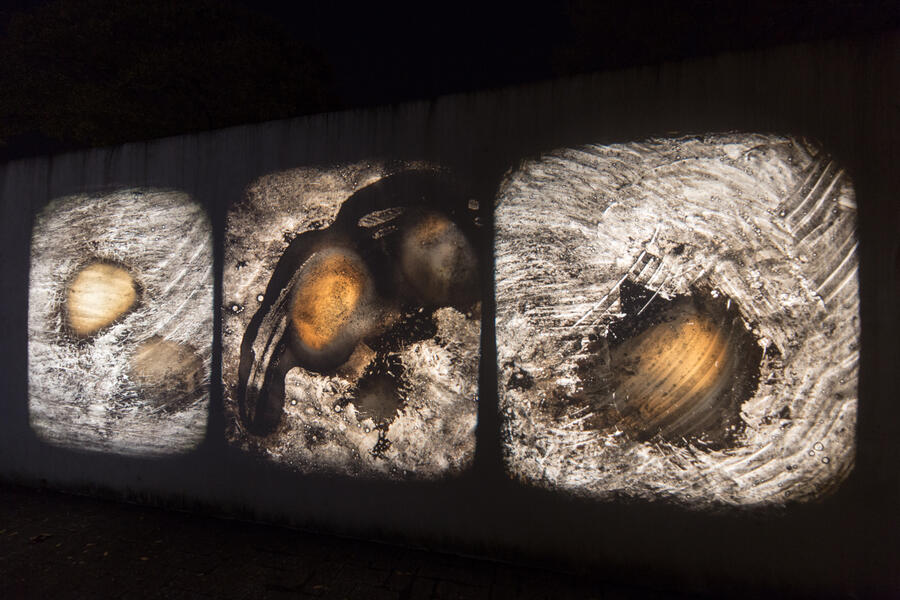 Luminescent Shadows: the Virginia Museum of Fine Art 2018
Luminescent Shadows: the Virginia Museum of Fine Art 2018 -
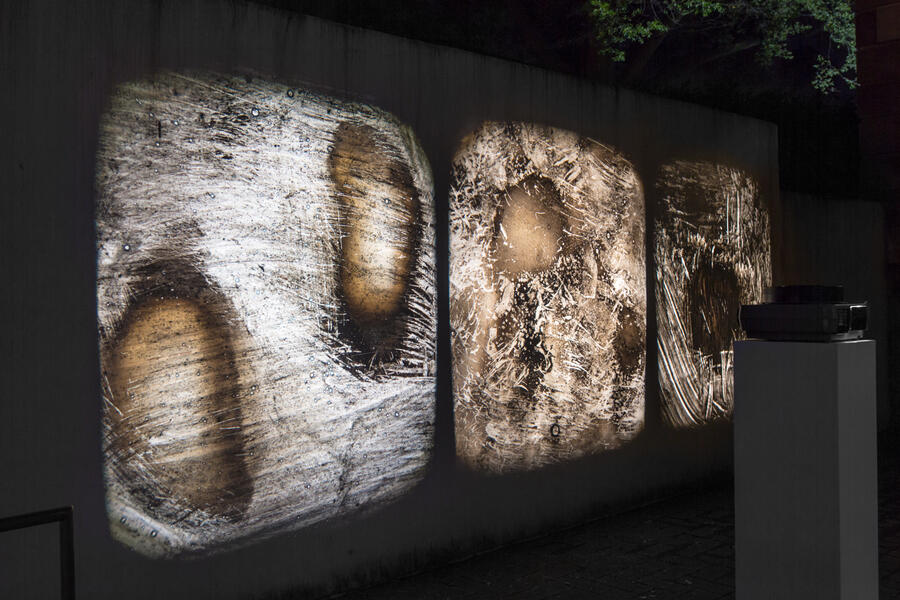 Luminescent Shadows: the Virginia Museum of Fine Art 2018
Luminescent Shadows: the Virginia Museum of Fine Art 2018 -
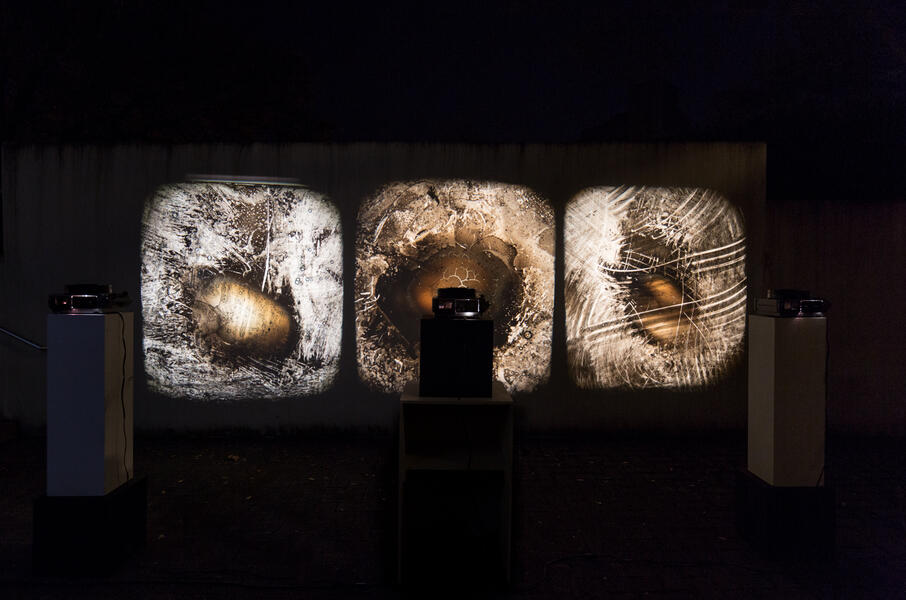 Luminescent Shadows: the Virginia Museum of Fine Art 2018
Luminescent Shadows: the Virginia Museum of Fine Art 2018 -
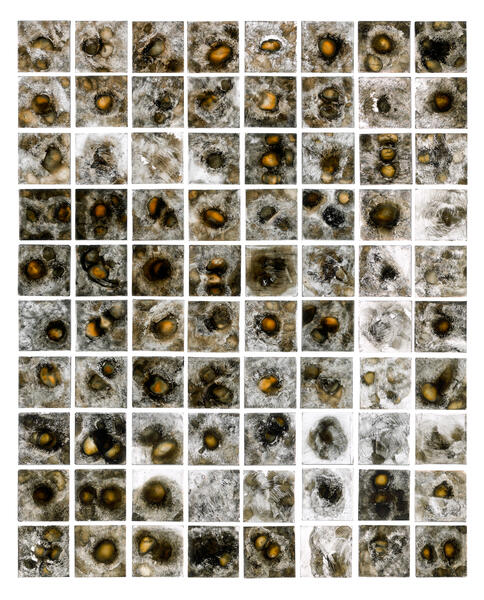 Luminescent Shadows: Slides
Luminescent Shadows: Slides -
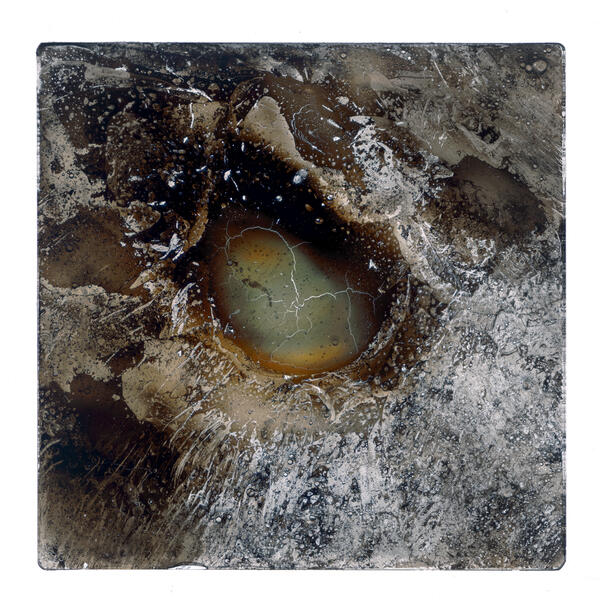 Luminescent Shadows: Slide detail
Luminescent Shadows: Slide detail -
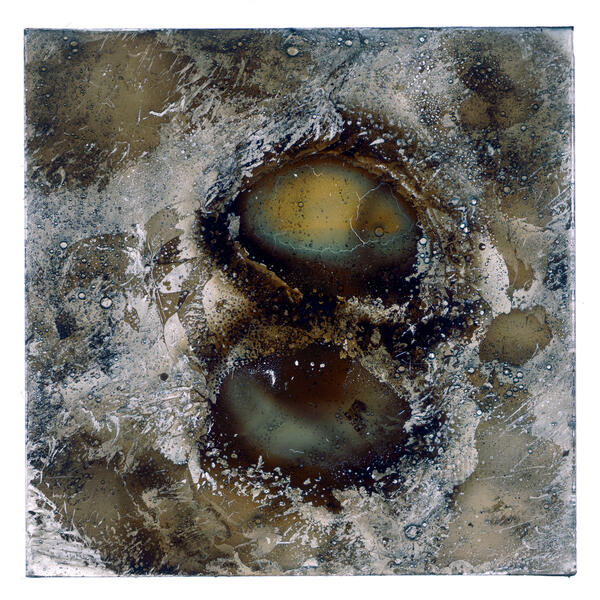 Luminescent Shadows: Slide detail 2
Luminescent Shadows: Slide detail 2 -
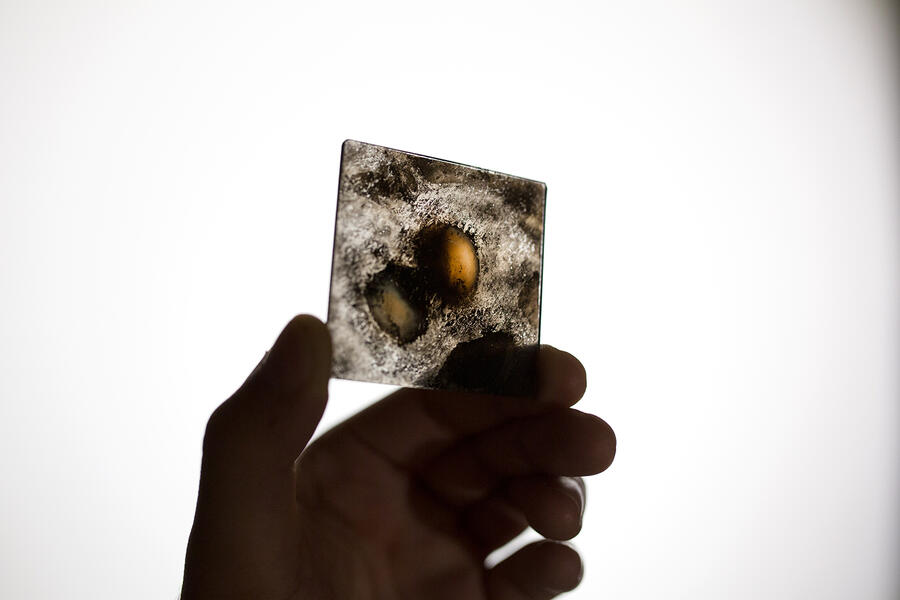 Luminescent Shadows: Slide detail 3
Luminescent Shadows: Slide detail 3
Ravaged Flower of the Future
Ravaged Flower of the Future is a triptych of C-print photogram made with sunlight and a sunflower grown with water I gathered from Fukushima after the Daiichi nuclear powerplant disaster. The photograms are placed upon the wall above a pile of burnt sunflower seeds titled, Death's Seedlings.
Sunflowers were a common sight among many on that bright morning in Hiroshima in 1945, a last possible sight for many. Today, sunflowers are believed to have an ability to clean radioactive soil by consuming the radiation through their roots. The study is still on-going and it may not be the short/quick solution, but I wonder if in the near future, a scientist will create a sunflower that can consume the radioactive material and can live off the radiation. And if so, it is only natural to think that the post nuclear apocalyptic world will be covered with sunflowers for the next few hundred years. Nothing but sunflowers, blowing radioactive ash in the contaminated wind.
Ravaged Flower of the Future
2018
Chromogenic Print, Sunlight, Sunflower
Installation: Various, Print: 60”x21”
Exhibition History:
2018: Creativce Alliance, MD
2019: Candela Gallery
-
 Ravaged Flower of the FutureA C-print photogram made with a sunflower grown with water of Fukushima.
Ravaged Flower of the FutureA C-print photogram made with a sunflower grown with water of Fukushima. -
 Ravaged Flower of the Future
Ravaged Flower of the Future -
 Ravaged Flower of the Future: Detail
Ravaged Flower of the Future: Detail -
 Ravaged Flower of the Future: Detail
Ravaged Flower of the Future: Detail -
 Ravaged Flower of the Future
Ravaged Flower of the Future -
 Death's SeedlingsBurnt Sunflower Seeds
Death's SeedlingsBurnt Sunflower Seeds -
 Death's Seedlings
Death's Seedlings -
 Death's Seedlings
Death's Seedlings
Only What We Can Carry
In the past, it may once have been a set of treasured letters brought to the camp during WWll. In these times, it could be a photo-filled cellphone or a laptop. But the suffocating decision of choosing between items of meaning and use to carry with you, or leave behind, must be the same. These objects, and these reaching gestures are all exposed with the poster, radiating through the C-prints like X-rays. They are juxtaposed in together as a warning, a warning that bridges the mistakes of the past with our time in the present.
-
 Only What We Can Carry: Stevenson University Gallery 2019Installation View at Stevenson University Gallery
Only What We Can Carry: Stevenson University Gallery 2019Installation View at Stevenson University Gallery -
 Civilian Exclusive Order No.11 : Paint knife and PalletOnly What We Can Carry is a series of 85 Contact C-Prints of Japanese Internment Camp (Executive Order 9066) posters exposed with various everyday objects. These everyday objects represent what I would bring with me if I had one day to gather my belongings. This poster became a symbol of bigotry and paranoia towards a specific group of people, and it echoes in these times where these same prejudices have reemerged for another group of people.
Civilian Exclusive Order No.11 : Paint knife and PalletOnly What We Can Carry is a series of 85 Contact C-Prints of Japanese Internment Camp (Executive Order 9066) posters exposed with various everyday objects. These everyday objects represent what I would bring with me if I had one day to gather my belongings. This poster became a symbol of bigotry and paranoia towards a specific group of people, and it echoes in these times where these same prejudices have reemerged for another group of people. -
 Civilian Exclusive Order No.25 : Smartphone
Civilian Exclusive Order No.25 : Smartphone -
 Civilian Exclusive Order No.36 : Spice
Civilian Exclusive Order No.36 : Spice -
 Civilian Exclusive Order No.22 : Small Frying Pan
Civilian Exclusive Order No.22 : Small Frying Pan -
 Civilian Exclusive Order No.94 : Headphone
Civilian Exclusive Order No.94 : Headphone -
 Civilian Exclusive Order No.108 : Familyphoto
Civilian Exclusive Order No.108 : Familyphoto -
 Civilian Exclusive Order No.42: Knife
Civilian Exclusive Order No.42: Knife -
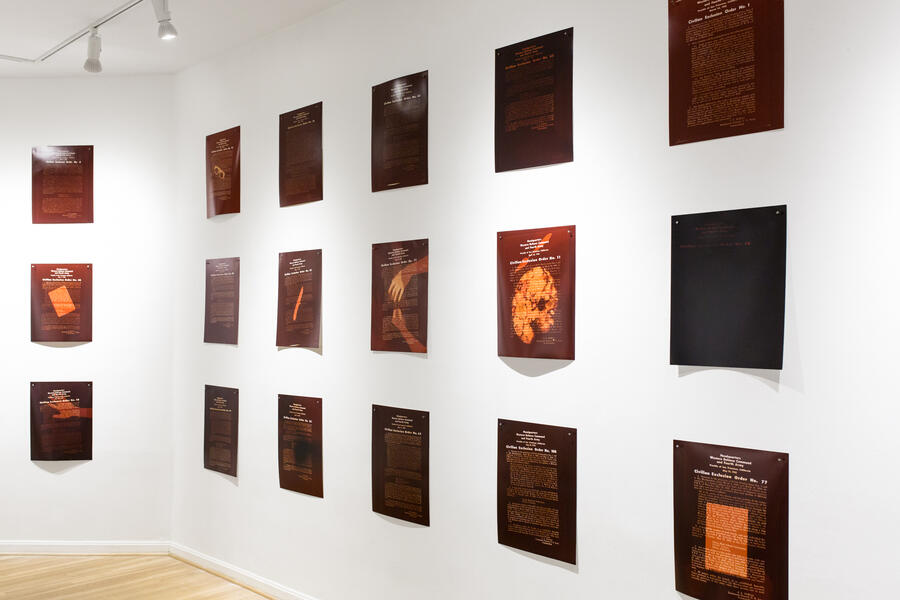 Only What We Can Carry: Hillyer Art Space/IA&A 2018Installation view at Hillyer Art Space/IA&A at Hillyer, Washington DC (2018)
Only What We Can Carry: Hillyer Art Space/IA&A 2018Installation view at Hillyer Art Space/IA&A at Hillyer, Washington DC (2018) -
 Only What We Can Carry: Hillyer Art Space/IA&A 2018Installation view at Hillyer Art Space/IA&A at Hillyer, Washington DC (2018)
Only What We Can Carry: Hillyer Art Space/IA&A 2018Installation view at Hillyer Art Space/IA&A at Hillyer, Washington DC (2018)
Ash Lexicon-Silverplate
The burnt Japanese dictionary stuffed in the canisters is the one that identical to the dictionary once owned by my grandfather. Upon returning his home, my grandfather found his cherished Japanese dictionary incinerated, and saw that the ink had turned white on the blackened pages, as if it were rendered into a photographic negative.
At the same time that the radiation from the atomic bomb was inscribing itself into my grandfather’s genes, the flames from the bomb burned everything in Hiroshima, including the Japanese dictionaries my grandfather greatly cared for. This archive of history and culture became ash, thereby recording the destructive force of this new human technology.
The accompanied audio made by Andrew Keiper is a soundscape inspired by the specially modified B-29 Superfortress heavy bombers used in the atomic attacks on Hiroshima and Nagasaki. Dubbed Silverplate Series, these planes not only carried and dropped the bombs, but performed other aspects of the missions, including scouting and observation.
Ash Lexicon-Silverplate
2016
Burnt Japanese Dictionary, 108 film canisters, burnt 2x4 stud, audio
Various
Exhibition History:
2016: Maryland Art Place, MD
2018: Antioch College, OH
2019: SECCA (Southeastern Center for Contemporary Art), NC
-
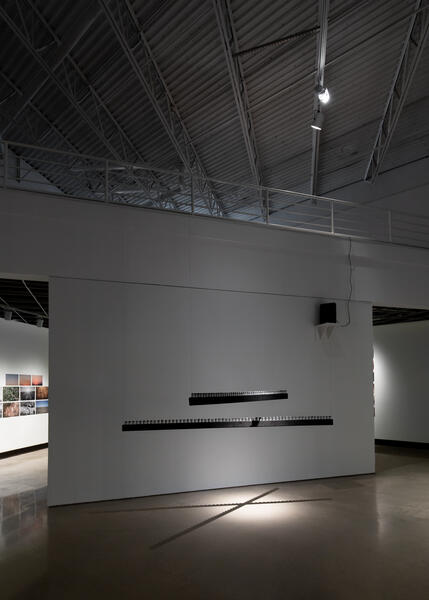 Ash Lexicon-Silverplate: SECCA 2019Installation view at Southeastern Center for Contemporary Art (SECCA) Winston-Salem, NC, (2019)
Ash Lexicon-Silverplate: SECCA 2019Installation view at Southeastern Center for Contemporary Art (SECCA) Winston-Salem, NC, (2019) -
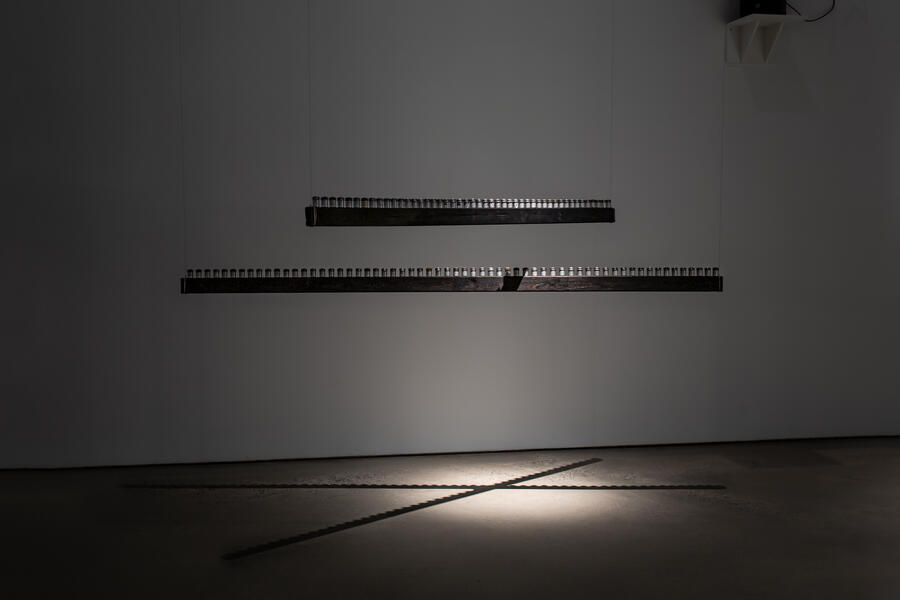 Ash Lexicon-Silverplate: SECCA 2019Installation view at Southeastern Center for Contemporary Art (SECCA) Winston-Salem, NC, (2019)
Ash Lexicon-Silverplate: SECCA 2019Installation view at Southeastern Center for Contemporary Art (SECCA) Winston-Salem, NC, (2019) -
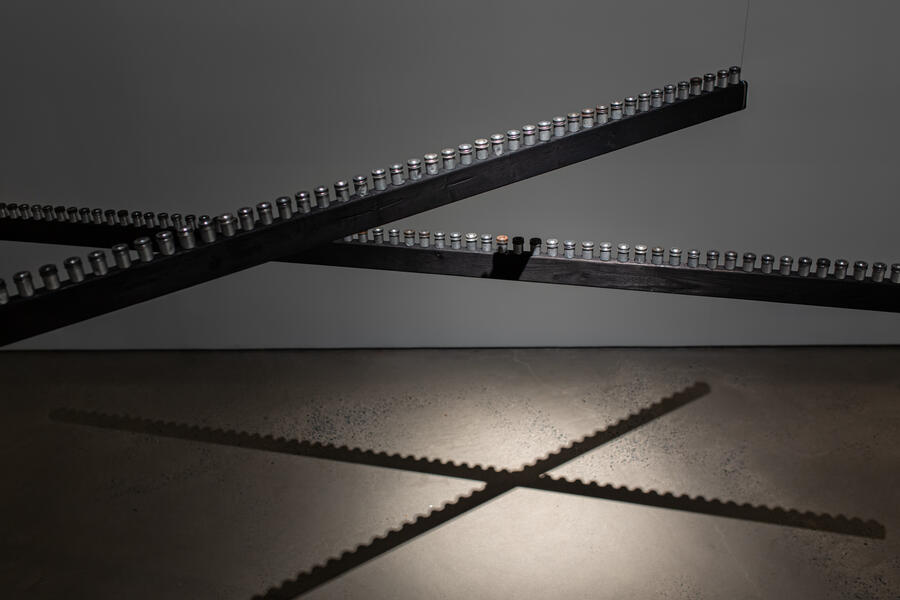 Ash Lexicon-Silverplate: SECCA 2019Installation view at Southeastern Center for Contemporary Art (SECCA) Winston-Salem, NC, (2019)
Ash Lexicon-Silverplate: SECCA 2019Installation view at Southeastern Center for Contemporary Art (SECCA) Winston-Salem, NC, (2019) -
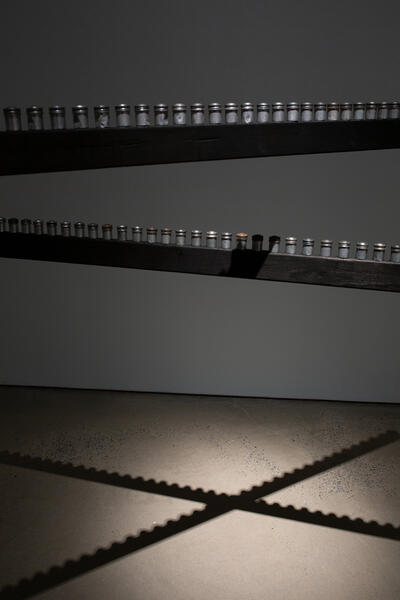 Ash Lexicon-Silverplate: SECCA 2019Installation view at Southeastern Center for Contemporary Art (SECCA) Winston-Salem, NC, (2019)
Ash Lexicon-Silverplate: SECCA 2019Installation view at Southeastern Center for Contemporary Art (SECCA) Winston-Salem, NC, (2019) -
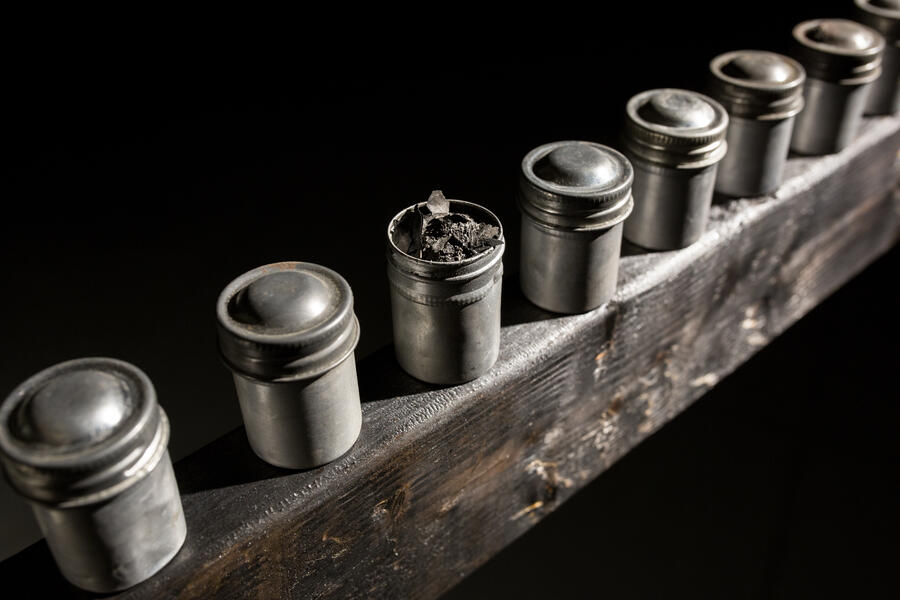 Ash Lexicon-Silverplate: SECCA 2019Installation view at Southeastern Center for Contemporary Art (SECCA) Winston-Salem, NC, (2019)
Ash Lexicon-Silverplate: SECCA 2019Installation view at Southeastern Center for Contemporary Art (SECCA) Winston-Salem, NC, (2019) -
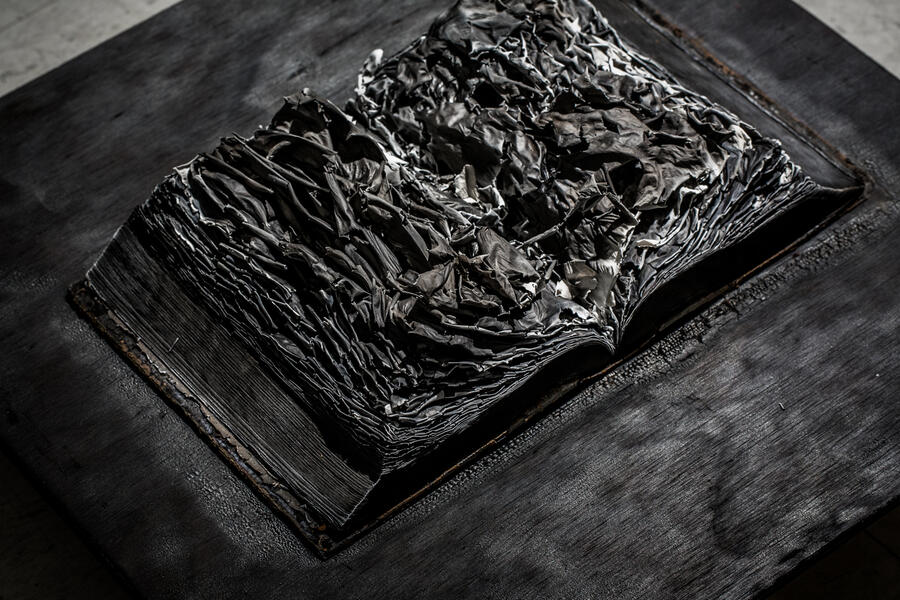 Ash Lexicon-Silverplate: Burnt Japanese dictionaryDocumentation of the burnt Japanese Dictionary before it was stuffed in the film canisters.
Ash Lexicon-Silverplate: Burnt Japanese dictionaryDocumentation of the burnt Japanese Dictionary before it was stuffed in the film canisters. -
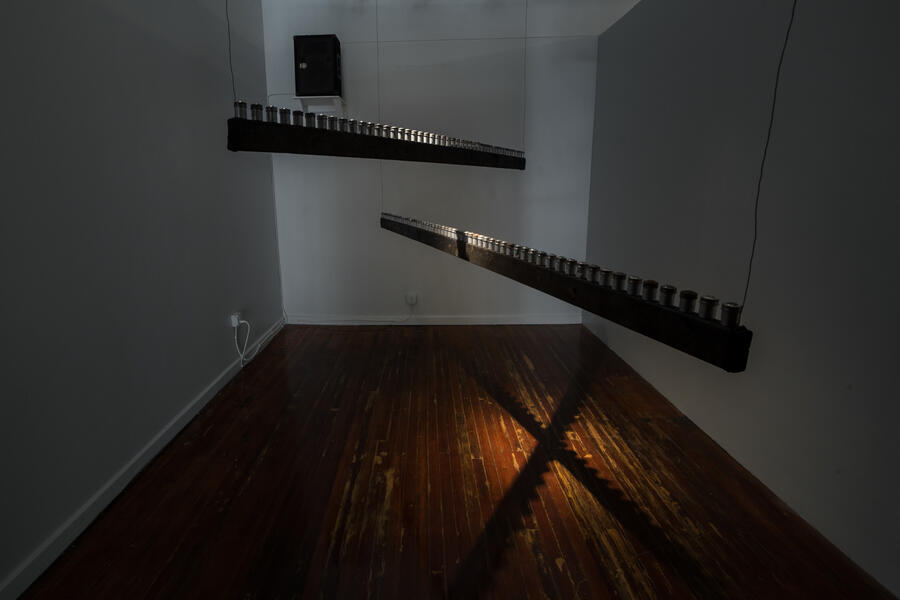 Ash Lexicon-Silverplate: Maryland Art Place 2016Installation view at Maryland Art Place, Baltimore, MD (2016)
Ash Lexicon-Silverplate: Maryland Art Place 2016Installation view at Maryland Art Place, Baltimore, MD (2016) -
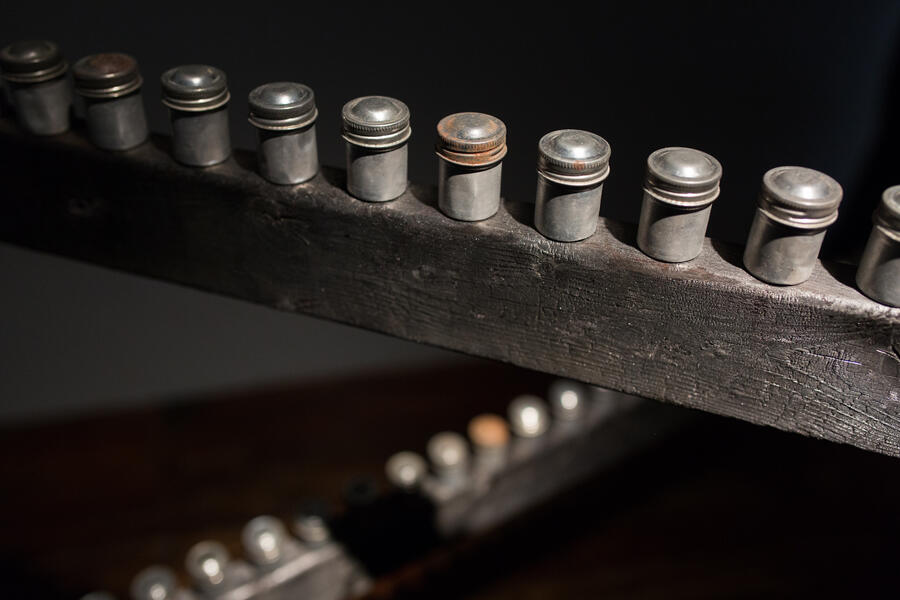 Ash Lexicon-Silverplate: Maryland Art Place 2016
Ash Lexicon-Silverplate: Maryland Art Place 2016 -
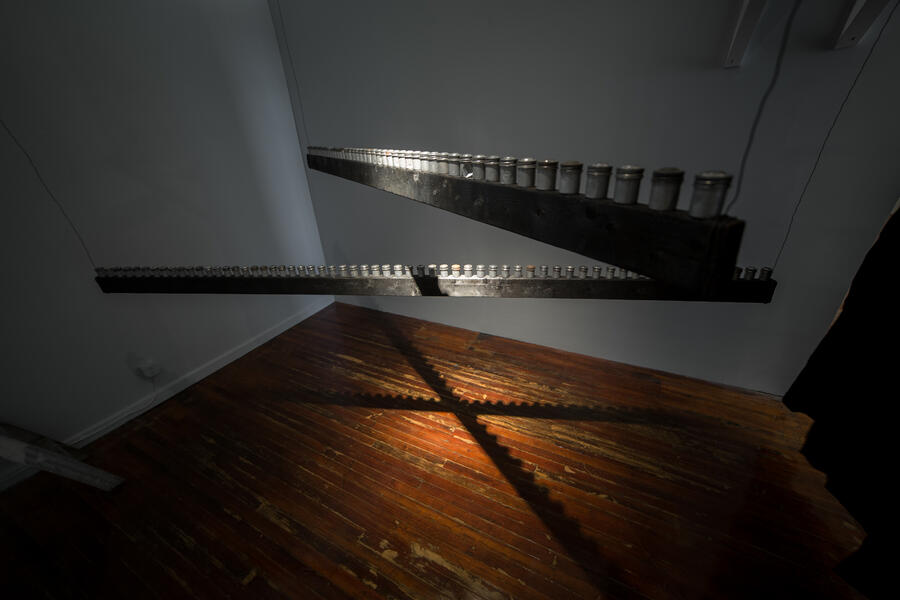 Ash Lexicon-Silverplate: Maryland Art Place 2016
Ash Lexicon-Silverplate: Maryland Art Place 2016 -
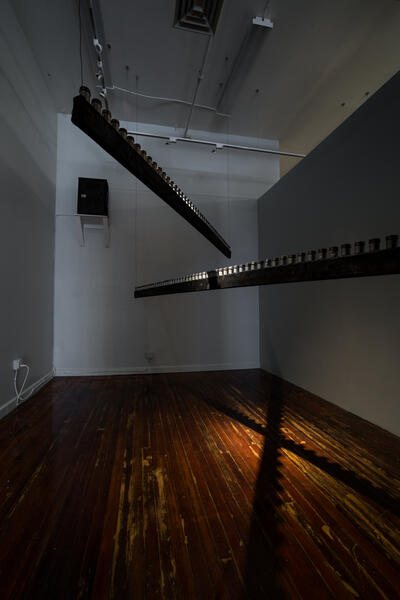 Ash Lexicon-Silverplate: Maryland Art Place 2016
Ash Lexicon-Silverplate: Maryland Art Place 2016
Am I Am a Mutant
Am I Am a Mutant consists of over 200 sun-fused photograms made from light sensitive paper, marquee letter plates, and sunlight. Alongside with framed photograms of captured shadows of superhero figures related to radiation. The use of marquee plates typically deployed to display and inform people of upcoming movies and plays, reflects the theatrical and spectacular nature of nuclear warfare depicted in the media and people’s resulting denial of reality around the actuality of a nuclear strike as if it is something illusionary.
All the poems are “written” vertically from left to right, echoing the duality of my cultural upbringing in both Japan and America. The lack of the space between the words further abstract these writings reflecting the difficulty of hearing the hidden and obscured voice of victims behind the blinding façade of vivid cartoons and catchy headlines of today’s nuclear climate.
Am I Am a Mutant
2020
Unique C-Print Photogram, Sunlight, Marquee Plates
Various
2020: Full Circle Fine Art, MD
2020: Harmony Hall ARt Center, DC
-
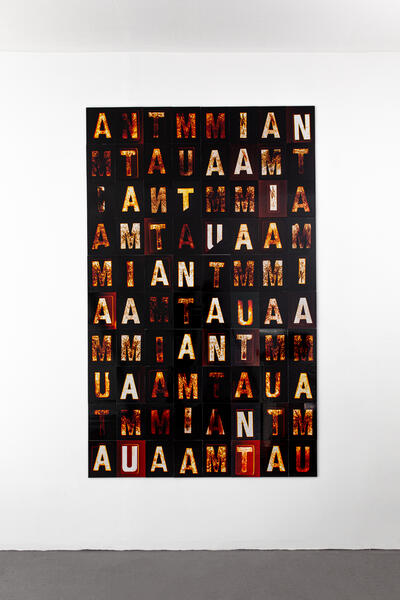 Am I Am A Mutant
Am I Am A Mutant -
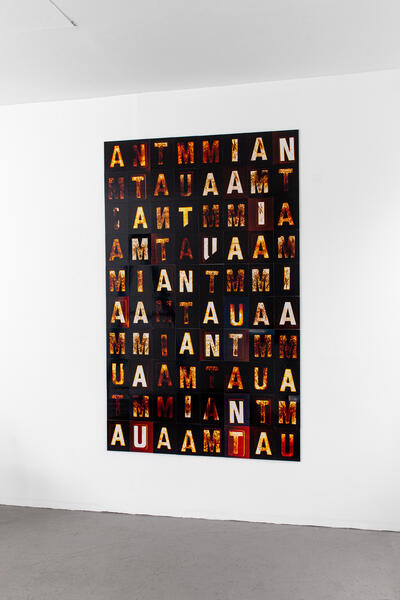 Am I Am A Mutant
Am I Am A Mutant -
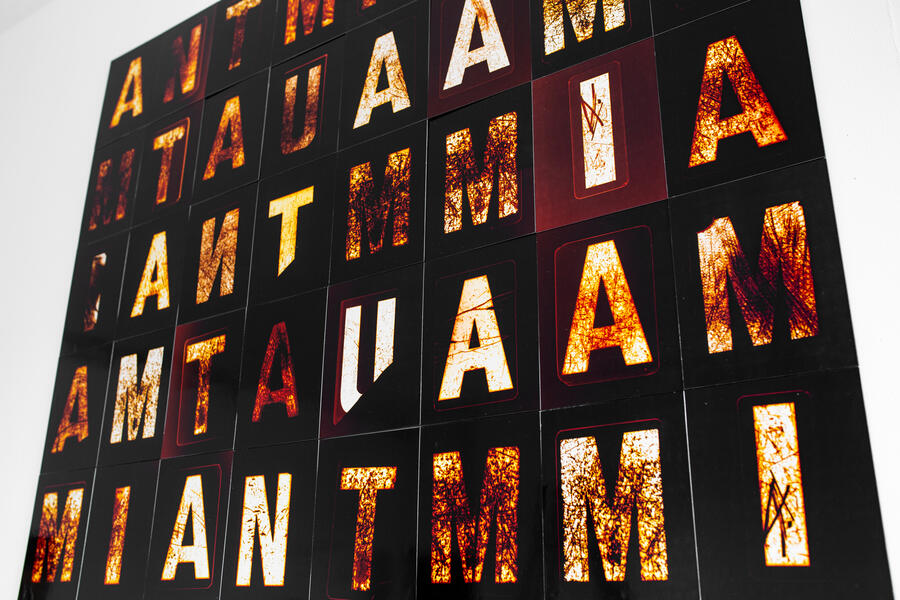 Am I Am A Mutant
Am I Am A Mutant -
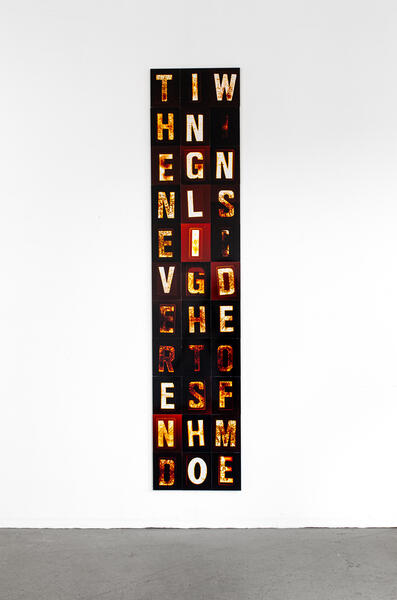 The Never Ending Lightshow"The never ending lightshow inside of me"
The Never Ending Lightshow"The never ending lightshow inside of me" -
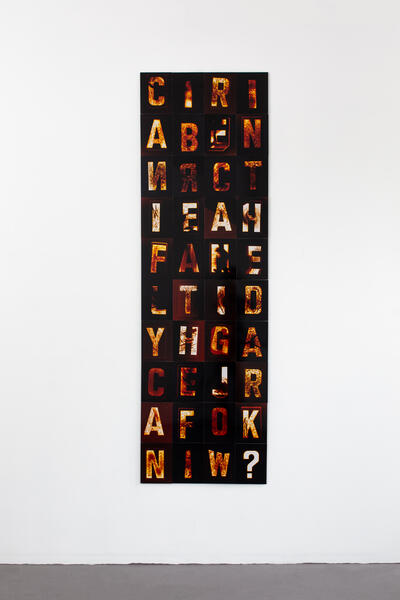 Can I"Can I fly, Can I breath fire, Can I Glow in the dark?"
Can I"Can I fly, Can I breath fire, Can I Glow in the dark?" -
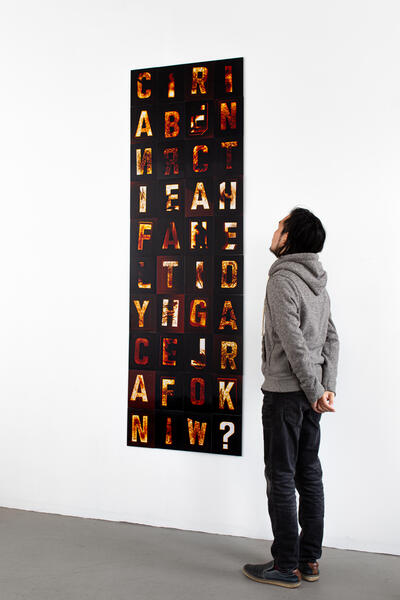 Can I"Can I fly, Can I breath fire, Can I Glow in the dark?"
Can I"Can I fly, Can I breath fire, Can I Glow in the dark?" -
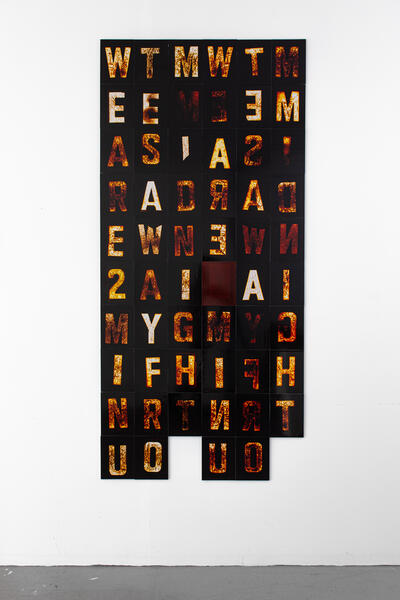 Midnight"We are 2 minutes away from the midnight. We are [ ] minutes away from the midnight."
Midnight"We are 2 minutes away from the midnight. We are [ ] minutes away from the midnight." -
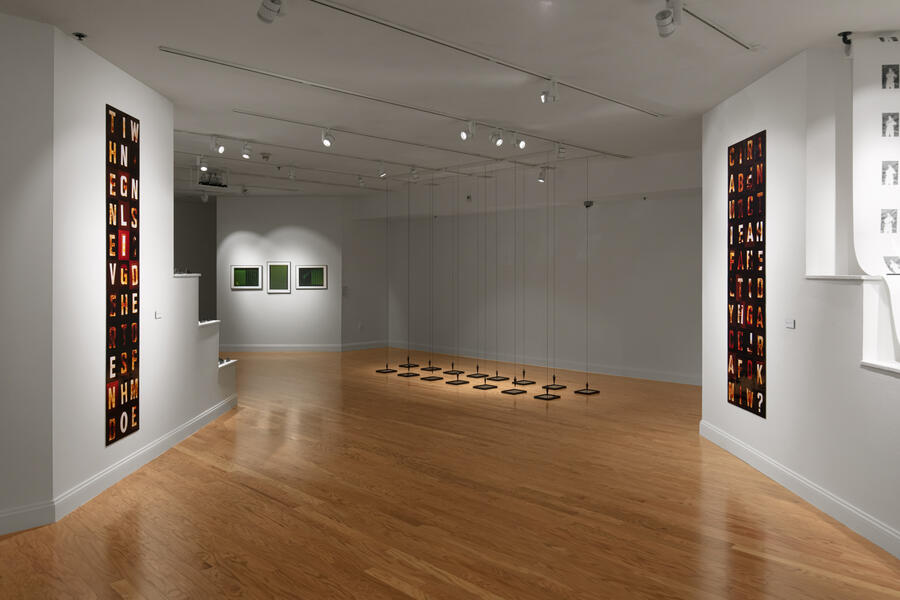 Am I Am I Mutant: Harmony Hall Art Center 2020Installation View at Harmony Hall Art Center, DC, 2020
Am I Am I Mutant: Harmony Hall Art Center 2020Installation View at Harmony Hall Art Center, DC, 2020 -
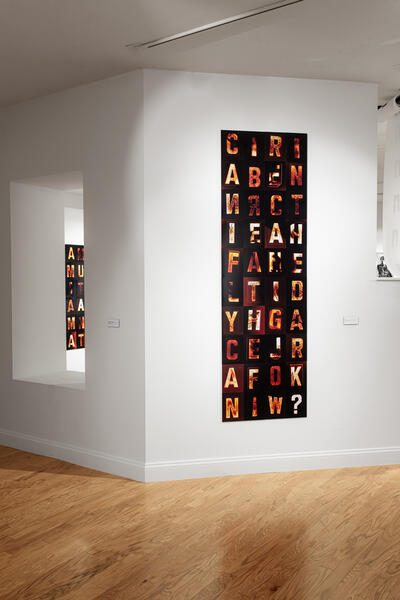 Am I Am I Mutant: Harmony Hall Art Center 2020Installation View at Harmony Hall Art Center, DC, 2020
Am I Am I Mutant: Harmony Hall Art Center 2020Installation View at Harmony Hall Art Center, DC, 2020 -
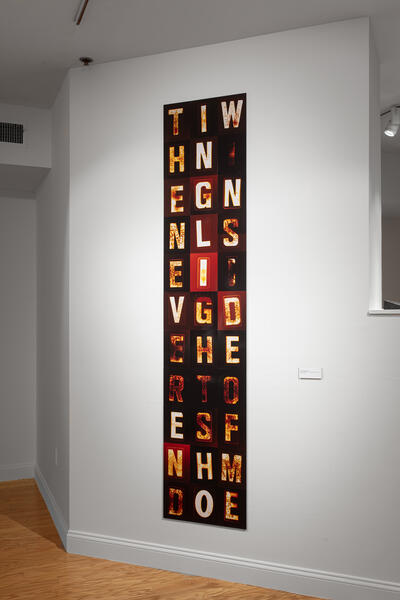 Am I Am I Mutant: Harmony Hall Art Center 2020Installation View at Harmony Hall Art Center, DC, 2020
Am I Am I Mutant: Harmony Hall Art Center 2020Installation View at Harmony Hall Art Center, DC, 2020
Hiroshima 08/06/2015 8:15am
The burnt Japanese dictionary shown in the view is the one that identical to the dictionary once owned by my grandfather. He once told through his book, upon returning to his home after the bombing, he found his cherished Japanese dictionary incinerated, and saw that the ink had turned white on the blackened pages, as if it were rendered into a photographic negative.
At the same time that the radiation from the atomic bomb was inscribing itself into my grandfather’s genes, the flame from the bomb burnt everything in Hiroshima, including the Japanese dictionaries my grandfather cherished. This archive of history and culture became ash, thereby recording the destructive force of this new human technology. One of my grandfather’s friends told me once “there is no word that can describe what we witnessed that day”.
Thirst
Collaboration with Alexa Rinn (PhD Peabody Institute of Music) Thirst is based on the story my grandfather once told me. If the death was the first thing the A-bomb gave to the people in Hiroshima, burnt flesh and unbearable thirst was the next. Many survivors jumped into a river to ease their deadly thirst. However, many of their throats were so burnt that they drown due to being unable to swallow the water. By the next morning, the river was filled with bodies staring at the sky and the sun.
Performed at the Walters Art Museum.
-
 Video stillsVideo stills
Video stillsVideo stills -
ThirstDuration: 7 minutes 18 seconds
-
 Thirst: Performance view at Walter Art Museum 2016Location: Walter Art Museum. Music performed to the video by Julia Kim (Violinist) and Catarina Ferreira (Cellist).
Thirst: Performance view at Walter Art Museum 2016Location: Walter Art Museum. Music performed to the video by Julia Kim (Violinist) and Catarina Ferreira (Cellist). -
 Thirst: Performance view at Walter Art Museum 2016
Thirst: Performance view at Walter Art Museum 2016 -
 Thirst: Performance view at Walter Art Museum 2016
Thirst: Performance view at Walter Art Museum 2016 -
 Thirst: Performance view at Walter Art Museum 2016
Thirst: Performance view at Walter Art Museum 2016






































